The first laser in history: how it was
As you know, a laser is a device capable of amplifying light by stimulated radiation. And the possibility of building this device was first predicted in theory, and only many years later it was possible to build the first sample. I recall that stimulated radiation was explained from the point of view of quantum theory by Einstein, and the first incarnation of this principle in iron began in the 50s of the 20th century independently by various groups of scientists, the most famous of which were C. Townes, AM Prokhorov and N. G Bass. Then they managed to build the first quantum generator - a maser, which generated radiation in the area of centimeter waves. The optical range remained unconquered at that time, and how I managed to conquer it I will try to tell you in this article.
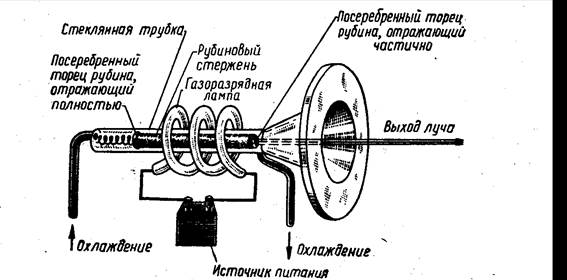
And Theodor Meiman succeeded in conquering him in the 1960s. He carried out many calculations and came to the conclusion that a ruby crystal would be an ideal working body for generating waves in the optical range. He also proposed the principle of pumping a working medium — short flashes of light from a corresponding flash lamp and a method of creating positive feedback for the amplifier to become a generator — this function was performed by the mirror coatings on the crystal ends. Meiman’s calculations showed that chromium atoms, which are an impurity in sapphire crystals and which make it a ruby, have a suitable system of energy levels that makes it possible to generate laser radiation. The ruby implements the simplest three-level scheme. The chromium atom, absorbing light in the blue-green region of the spectrum, goes to the upper excited level, from which there is a non-radiative transition to a metastable level at which it can linger for a time on the order of 1 ms. From this state, the atom returns to the ground level, emitting a photon with a wavelength of either 694 or 692 nm, since the metastable level is actually not one, there are two very closely spaced ones. The possibility of accumulation of atoms at the metastable level and allows you to create an inverse population, and with it the generation of laser radiation, when one or more spontaneously emitted photons cause all other atoms to crumble all other atoms from the metastable state to the ground one, emitting new photons with the same wavelength, phase, polarization and direction of motion. They create a bright red beam, which is characteristic of coherence. on which he can stay for about 1 ms. From this state, the atom returns to the ground level, emitting a photon with a wavelength of either 694 or 692 nm, since the metastable level is actually not one, there are two very closely spaced ones. The possibility of accumulation of atoms at the metastable level and allows you to create an inverse population, and with it the generation of laser radiation, when one or more spontaneously emitted photons cause all other atoms to crumble all other atoms from the metastable state to the ground one, emitting new photons with the same wavelength, phase, polarization and direction of motion. They create a bright red beam, which is characteristic of coherence. on which he can stay for about 1 ms. From this state, the atom returns to the ground level, emitting a photon with a wavelength of either 694 or 692 nm, since the metastable level is actually not one, there are two very closely spaced ones. The possibility of accumulation of atoms at the metastable level and allows you to create an inverse population, and with it the generation of laser radiation, when one or more spontaneously emitted photons cause all other atoms to crumble all other atoms from the metastable state to the ground one, emitting new photons with the same wavelength, phase, polarization and direction of motion. They create a bright red beam, which is characteristic of coherence. since the metastable level is actually not one, there are two very closely spaced ones. The possibility of accumulation of atoms at the metastable level and allows you to create an inverse population, and with it the generation of laser radiation, when one or more spontaneously emitted photons cause all other atoms to crumble all other atoms from the metastable state to the ground one, emitting new photons with the same wavelength, phase, polarization and direction of motion. They create a bright red beam, which is characteristic of coherence. since the metastable level is actually not one, there are two very closely spaced ones. The possibility of accumulation of atoms at the metastable level and allows you to create an inverse population, and with it the generation of laser radiation, when one or more spontaneously emitted photons cause all other atoms to crumble all other atoms from the metastable state to the ground one, emitting new photons with the same wavelength, phase, polarization and direction of motion. They create a bright red beam, which is characteristic of coherence. when one or several spontaneously emitted photons cause all other atoms to “drop” from the metastable state to the ground state, emitting new photons with the same wavelength, phase, polarization and direction of motion. They create a bright red beam, which is characteristic of coherence. when one or several spontaneously emitted photons cause all other atoms to “drop” from the metastable state to the ground state, emitting new photons with the same wavelength, phase, polarization and direction of motion. They create a bright red beam, which is characteristic of coherence.
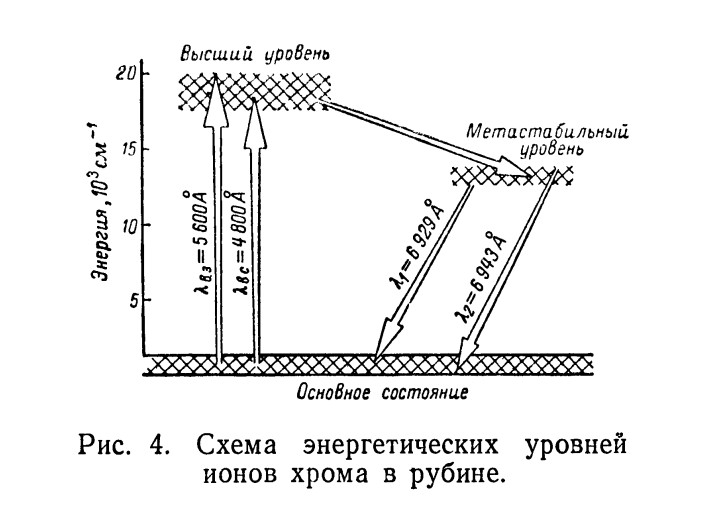
Many quite interesting and sometimes very unfair events are connected with the history of the invention of the first optical quantum generator. First, it should be noted that the development of the first laser Meiman carried out on his own initiative and independently, only with his assistant, while the ruby laser was created contrary to the opinions of many experts who were convinced that the ruby is not suitable as a working environment. There is a city legend, according to which, his assistant, being a color blind, for the first time in his life saw a red light, at that moment when the laser was assembled and he started working. According to the same legend, Meiman did not observe the laser beam visually, as he was very busy with the settings of the recording equipment - it was necessary to urgently collect experimental data and prepare the article for publication, in which convincing evidence will be presented that coherent radiation of the optical range was first obtained. This is where the difficulties began. First, Meyman’s article that the generation of coherent optical radiation in a ruby crystal is possible was rejected from the publication in the journal Physical Review Letters, adding that “there’s nothing fundamentally new in his article”. Instead, the article was published in Nature. What is characteristic is that in 1958, an article about the principles of laser operation, directed from a rival organization Bell Labs, was already published in Physical Review Letters, and this despite the fact that they did not have a working laser copy, the article described just a theoretical justification. They quickly cooked up a patent for a laser, which they did not yet have. And Meiman got a deviation from this magazine, although built the first workable laser. Moreover, he later explained in detail to the scientists from Bell Labs in a telephone conversation what it takes to create a laser and how to build it, after he created his own. However, the priority of Meyman in the invention of the laser was never recognized. Yes, and the Nobel Prize for the invention of the laser was awarded to Charles Townes, and not to him, who was supposed to belong to him by right. This is partly explained by the fact that Meiman worked in a private firm that carried out orders for the military, and not in the university laboratory. Yes, and the Nobel Prize for the invention of the laser was awarded to Charles Townes, and not to him, who was supposed to belong to him by right. This is partly explained by the fact that Meiman worked in a private firm that carried out orders for the military, and not in the university laboratory. Yes, and the Nobel Prize for the invention of the laser was awarded to Charles Townes, and not to him, who was supposed to belong to him by right. This is partly explained by the fact that Meiman worked in a private firm that carried out orders for the military, and not in the university laboratory.
Now, let's leave the drama alone and see how Meiman's ruby laser was made in the gland. The design was extremely simple - in a compact case was a miniature spiral flash lamp, inside which was fixed even more miniature ruby crystal. The opposite ends of it were silver-plated - one end was a “deaf” mirror, the second was silver-plated with a thinner layer that let in a certain amount of light. The first laser in the world was 12 centimeters long, weighed 300 grams and looked like a toy.

Details of the laser close-up:
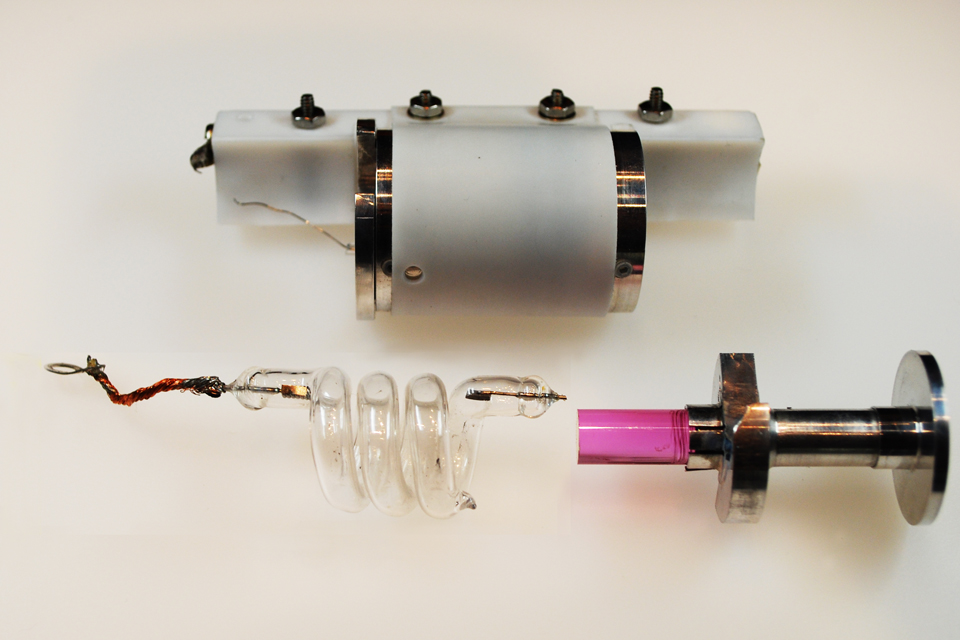
Actually, a ruby crystal.
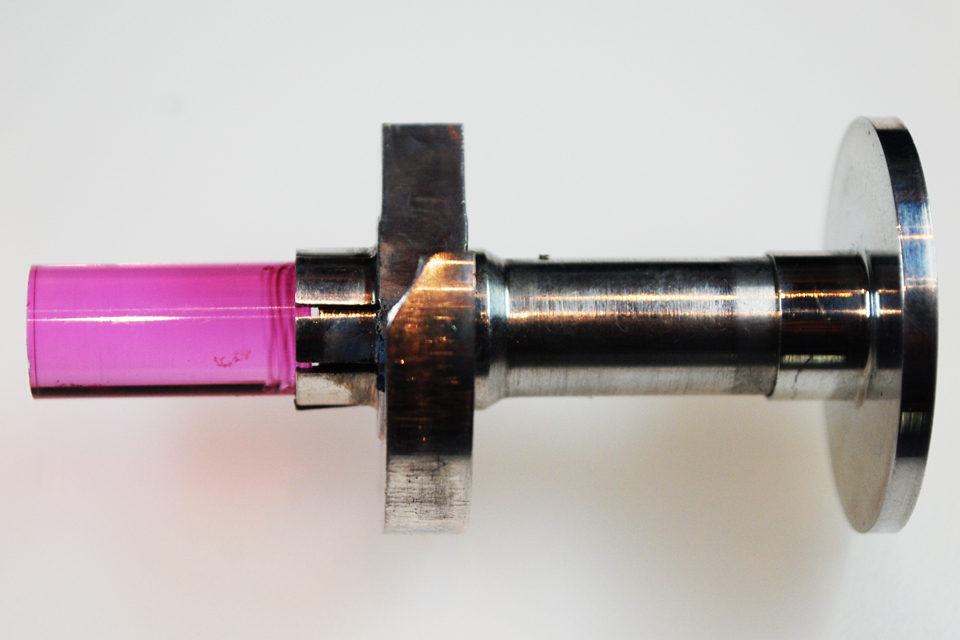
And the entire laser assembly, without a power source.
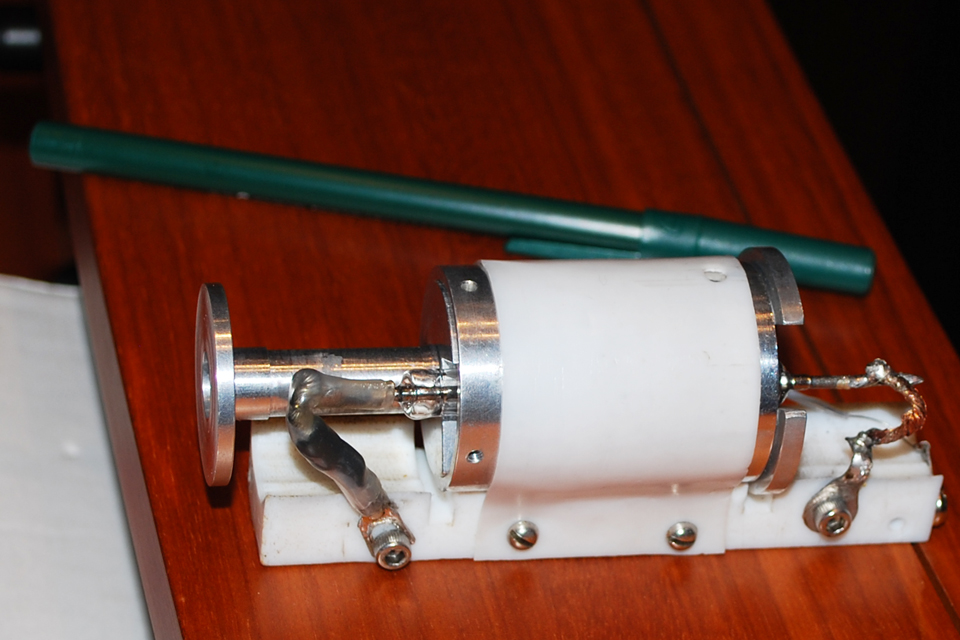
The photo also got a photo of a laser of a larger size, but by no means the first in history. And the journalists immediately began to raise panic, they say, the "death rays" were invented.
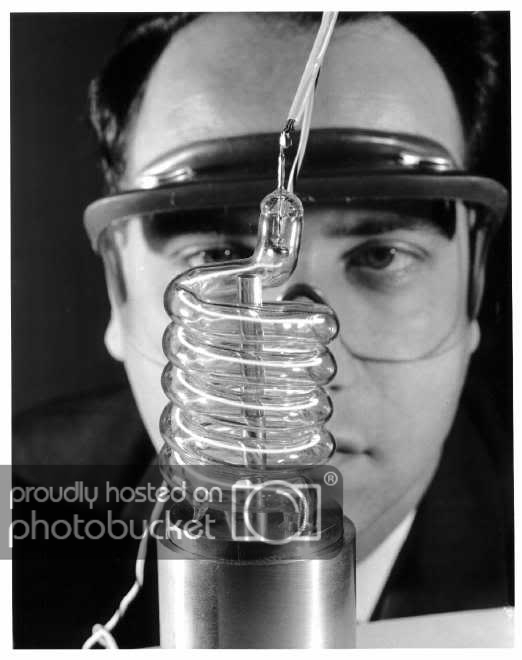
Literally a year or two later, when the news of the invention of the laser had already spread around the world, the first laboratory samples of lasers in the USSR began to appear. Unlike Western countries, spiral pump lamps in lasers did not catch on immediately. Firstly, the spiral lamp in spite of its “obviousness” has far from the optimal shape of the glow body - only a small fraction of the light goes to the address, since the neighboring turns of the spiral mainly illuminate each other, rather than a ruby crystal inserted inside it. Secondly - the Soviet industry did not produce a wide range of spiral flash lamps. And those that were produced had the wrong shape - the helix was too large in diameter but few turns, such as the fairly well-known lamps IFK-20000 and IFK-80000. There was a spiral modification in the fairly well-known and widespread IFK-2000 lamp, but it is very rare and could only “pump” the smallest crystal of ruby, like Meiman’s. Since spiral lamps in the USSR were rare, they took the path of using those lamps that are in sufficient quantity. The first laser in the USSR had the opportunity to install crystals of various sizes into it, and the “classic” U-shaped lamps IFK-2000 were used for pumping. So he looked "alive."

And so it was shown in the books of B. F. Fedorov of various publications.

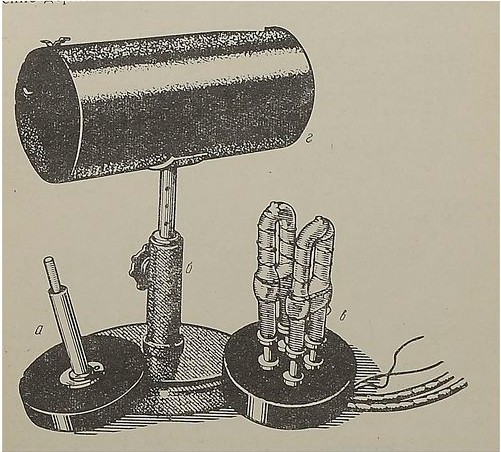
Since this method of pumping still remains inefficient, it quickly went away in favor of pumping with direct tubular lamps of the IFP series. Ruby crystals also began to be produced only a few standard sizes, exactly the size of the luminous part of the lamp. The ruby crystal and the lamp were placed in the foci of an elliptical reflector so that the crystal would collect the maximum available light. So it looks like a schematic.

And it looks like an elliptical reflector live.

There was also a design with the so-called "cavity" lamp. A cavity lamp is obtained by gradually increasing the number of turns in the spiral lamp to infinity, until they merge into a solid cavity. Such a lamp consists of two quartz glass tubes nested inside one another and soldered at the ends. Electrodes are soldered to opposite ends of the lamp. The only well-known Soviet-made cavity lamp, IPPP-7000, was used in pumping the UIG-1 laser setup.
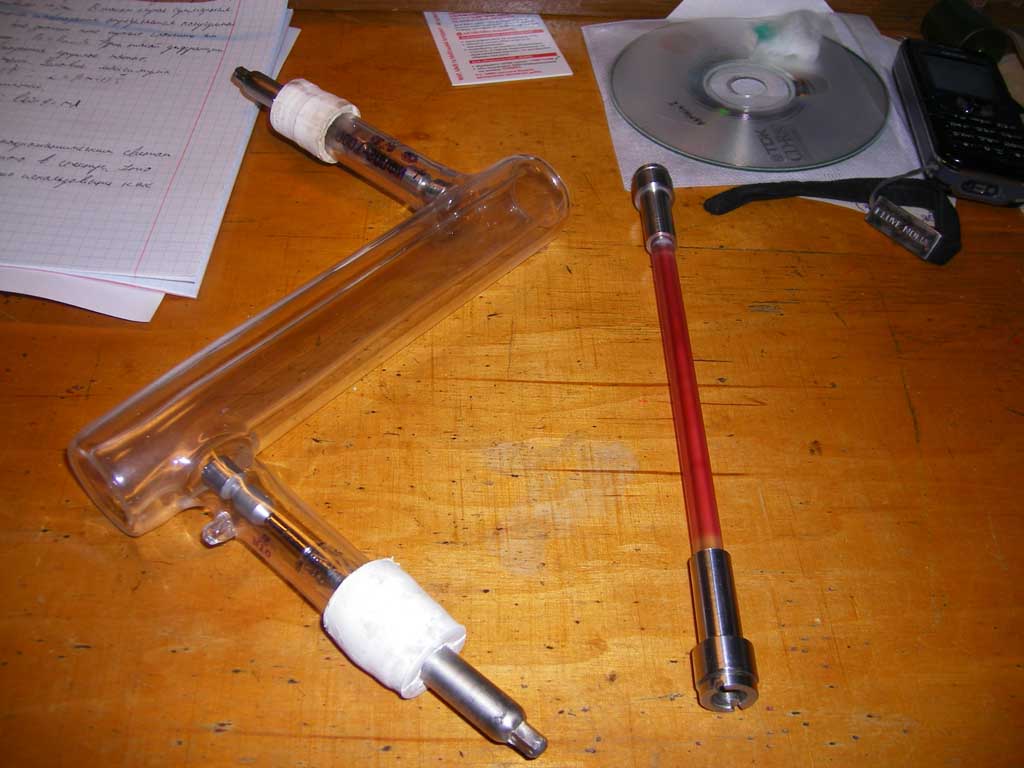
Such a pumping circuit has all the drawbacks of a spiral lamp circuit, and therefore has not been applied anywhere else. The photo shows the IPPP-7000 lamp and a ruby crystal used with it. In addition to the now exotic circuits with spiral and cavity pump lamps, the ruby laser can work in an even more exotic scheme - with continuous pumping. This is possible if the ruby crystal is very small, is cooled with liquid nitrogen and is illuminated by a focused beam from a superhigh-pressure mercury lamp or a high-power argon laser beam. But such devices did not leave the walls of the laboratories, remaining exotic, described in scientific articles, despite the fact that over time he was able to "wean" from liquid nitrogen. Subsequently, they refused from the mirrors sprayed on the ends, since they are short-lived and in case of damage they will have to change the whole crystal. This design has been preserved only in those devices where maximum compactness is needed, such as, for example, in laser emitters of epilators. In all other mirrors mounted separately on the adjustment devices.
It would be strange if I didn’t want to build my own ruby laser using animprovised and pasture emitted from the laser laboratory. I wanted to give a kind of tribute to history. Well, get the first experience with pulsed solid-state lasers. This is followed by a description of the construction of my own ruby laser.
The information is presented for informational purposes only. The author is not responsible for trying to repeat the above.
The basis was the above-mentioned crystal from the installation of UIG-1. This is a crystal of pale pink color with the size of the working colored part of 8 * 120 mm, with additional colorless tips, which gives a total crystal length of 180 mm. Tips needed for mounting the crystal in the emitter housing. Another reason why the colored part is made exactly according to the size of the pump lamp is that the ruby has an extremely poor ability to absorb its own radiation at the generation wavelength. If any part of the crystal remains unoccupied, then it begins to absorb radiation, which is amplified in the lighted part, and the efficiency of the laser is greatly reduced. Due to this three-level scheme of chromium atoms in ruby. For the same reason, the ruby has a very high threshold pumping energy.
The first was built power supply layout for the pumping lamp. Its main component is a battery of 1000 μF capacitors, which is charged up to 3 kV.
Let me remind you that circuits with high-voltage high-capacity capacitors are deadly!

The charge and ignition scheme of the lamp. For the first attempt taken IPP-5000.
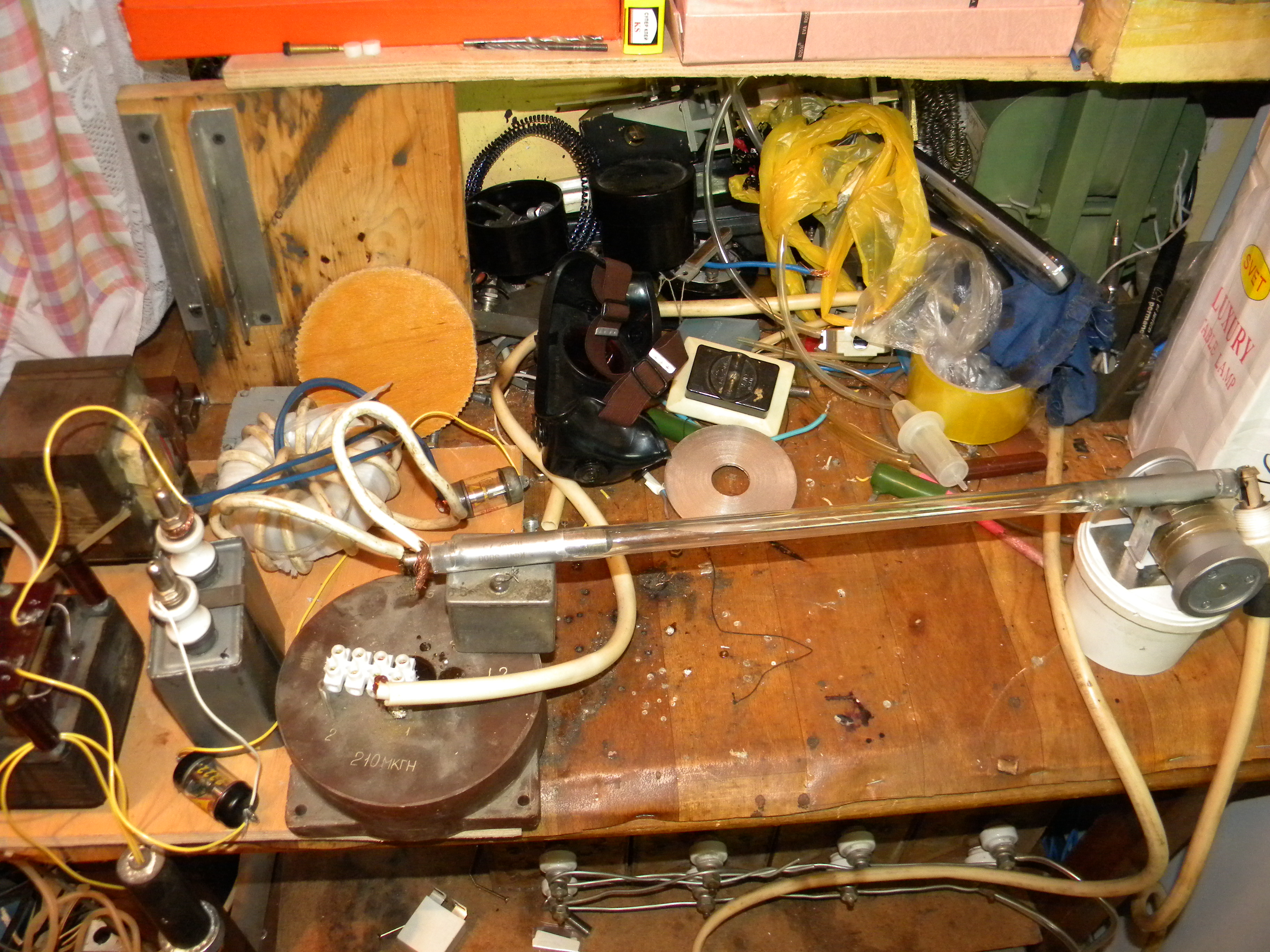
At first the circuit with the lamp was tested without any housing. The flash of the lamp is extremely powerful, it happens with a sufficiently loud pop, and it is easily seen in the next rooms - the light propagates through the corridor, reflecting off the walls. The flash of the lamp is capable of charring wood and paper, placed against it at its support. Each flash is accompanied by the smell of burnt dust and ozone, produced by a powerful impulse of a hard ultraviolet, and is accompanied by a wave of heat, if you are near it. Direct flash observation without eye protection is extremely dangerous! For protection, a conventional welding mask or goggles is sufficient.
Having played enough with the most powerful flashlight at that time, I assembled an emitter with this lamp and the crystal shown above. The case for the lamp and the crystal was a glass monoblock reflector from the Kvant-16 technological laser, and a piece of metal channel became the basement. Alignment devices for resonator mirrors were made from pieces of the same channel.
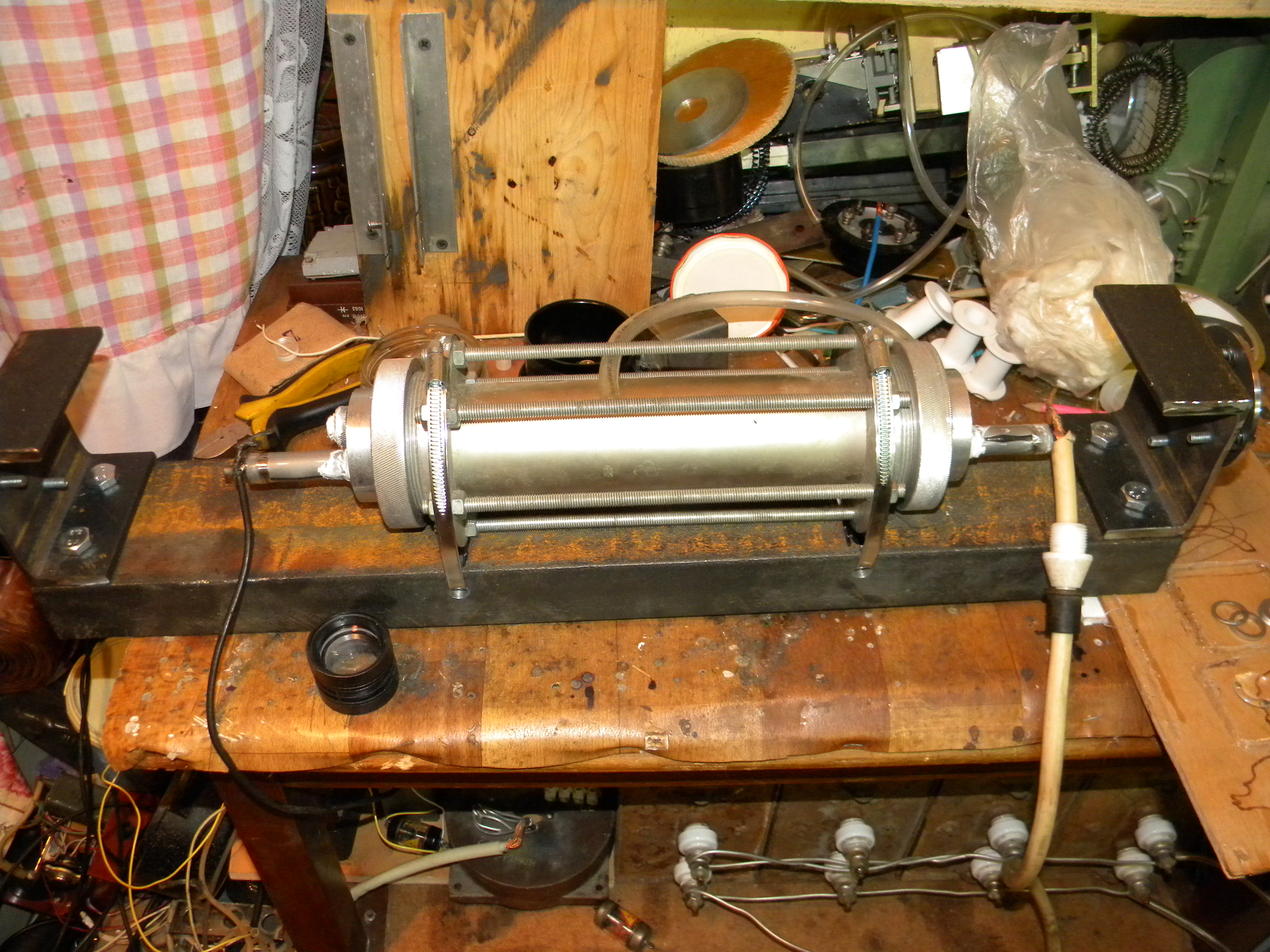
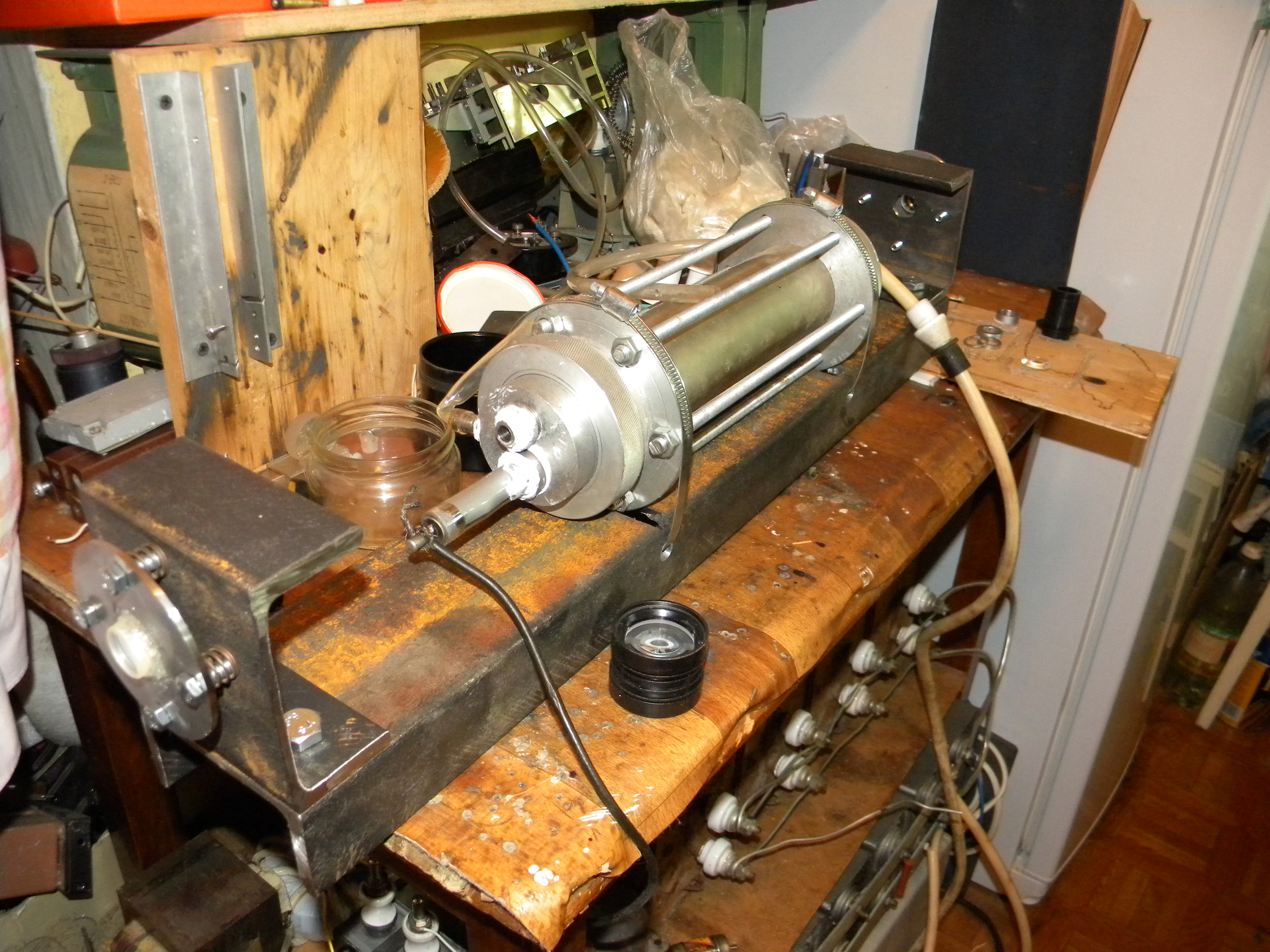
As a deaf mirror, I decided to use the prism of total reflection.
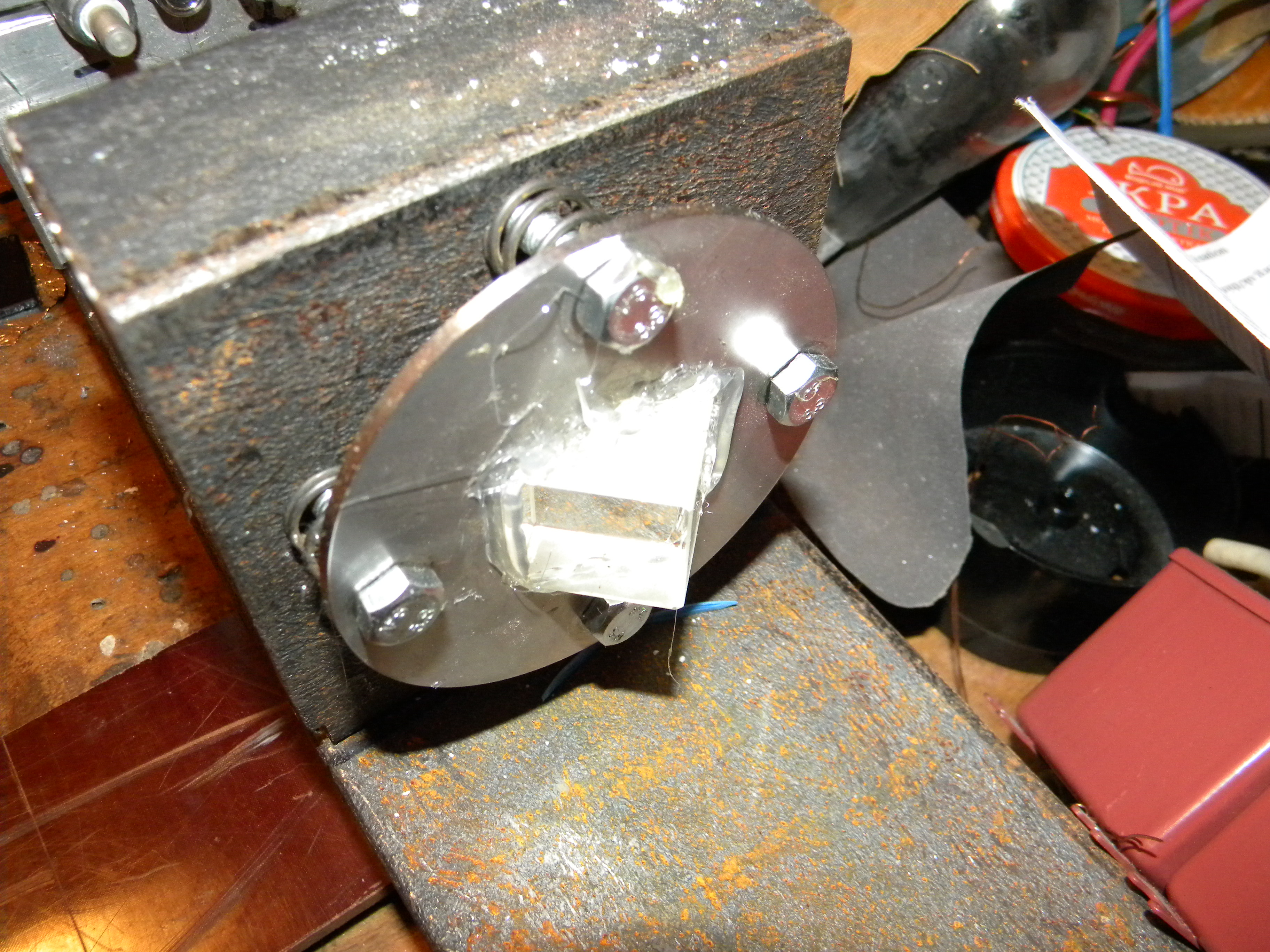
And as a day off, a mirror was supposedly chosen from a ruby laser.
Looking ahead, I will say that this construct was inoperative. Laser generation was not possible to get on it. The reasons are quite obvious - the pumping lamp is twice as long as the crystal and its light is used extremely inefficiently. And the possibility of the output mirror to provide this generation also raised questions. Quantron (the so-called lamp unit + crystal + reflector) had to be redone. In the second version, I made a new holder for the crystal and the lamps, instead of a single lamp, the IFP5000 decided to use two IFP2000 lamps placed in the focus against the crystal and connected in series electrically. The length of the IPP2000 ideally corresponds to the length of the colored part of the crystal. This layout method is called “tight packaging.”
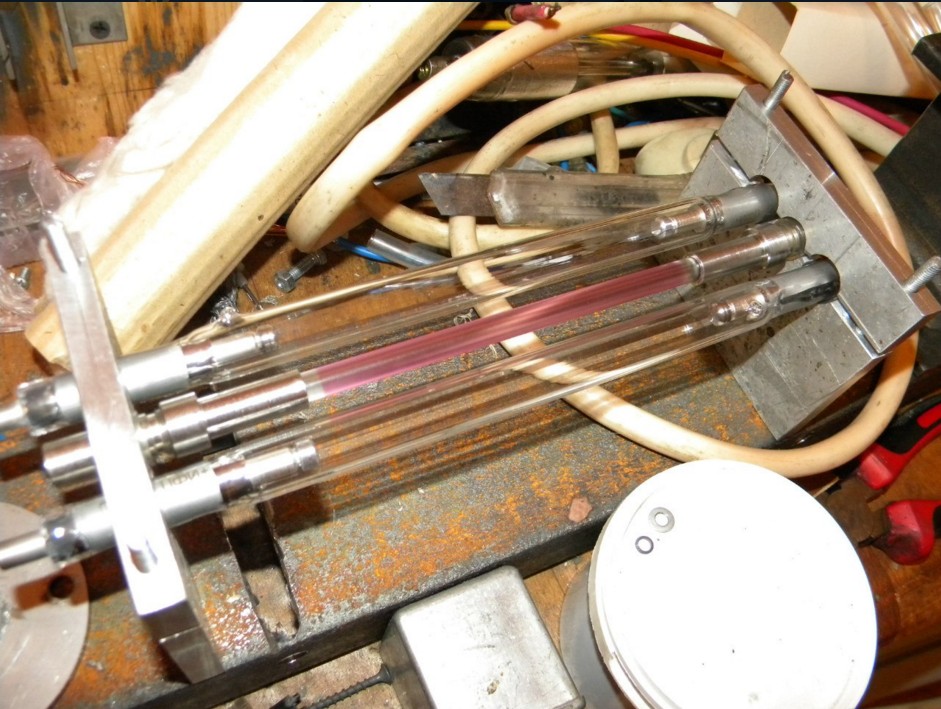
As a reflector, it was decided to try white tiles. The current trend in commercial laser engineering is the use of ceramic diffuse reflectors made of sintered aluminum oxide, which reflects up to 97% of the incident light. Of course, branded reflectors are not available to me, but the tiles look just as good, also perfectly white.
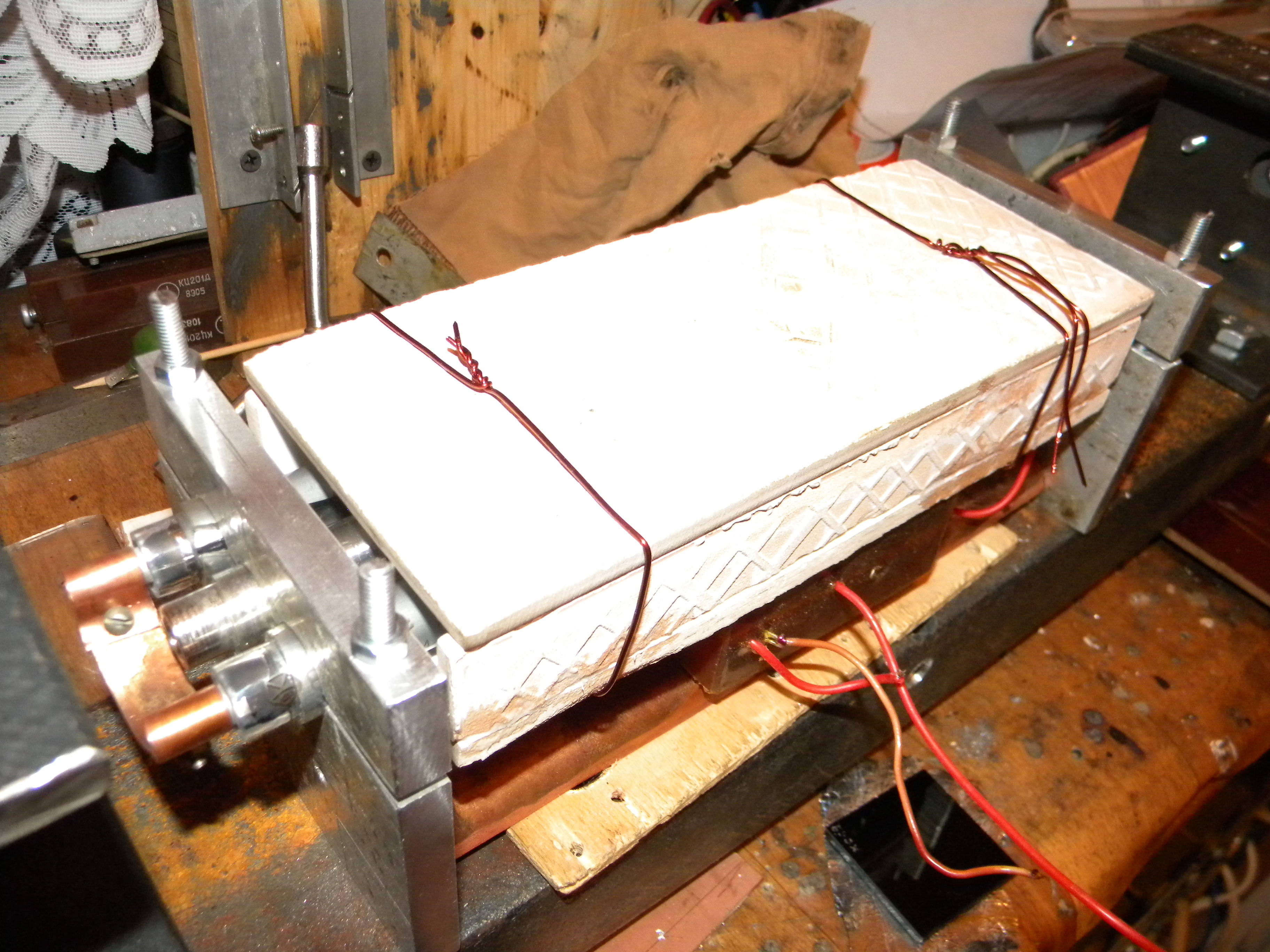
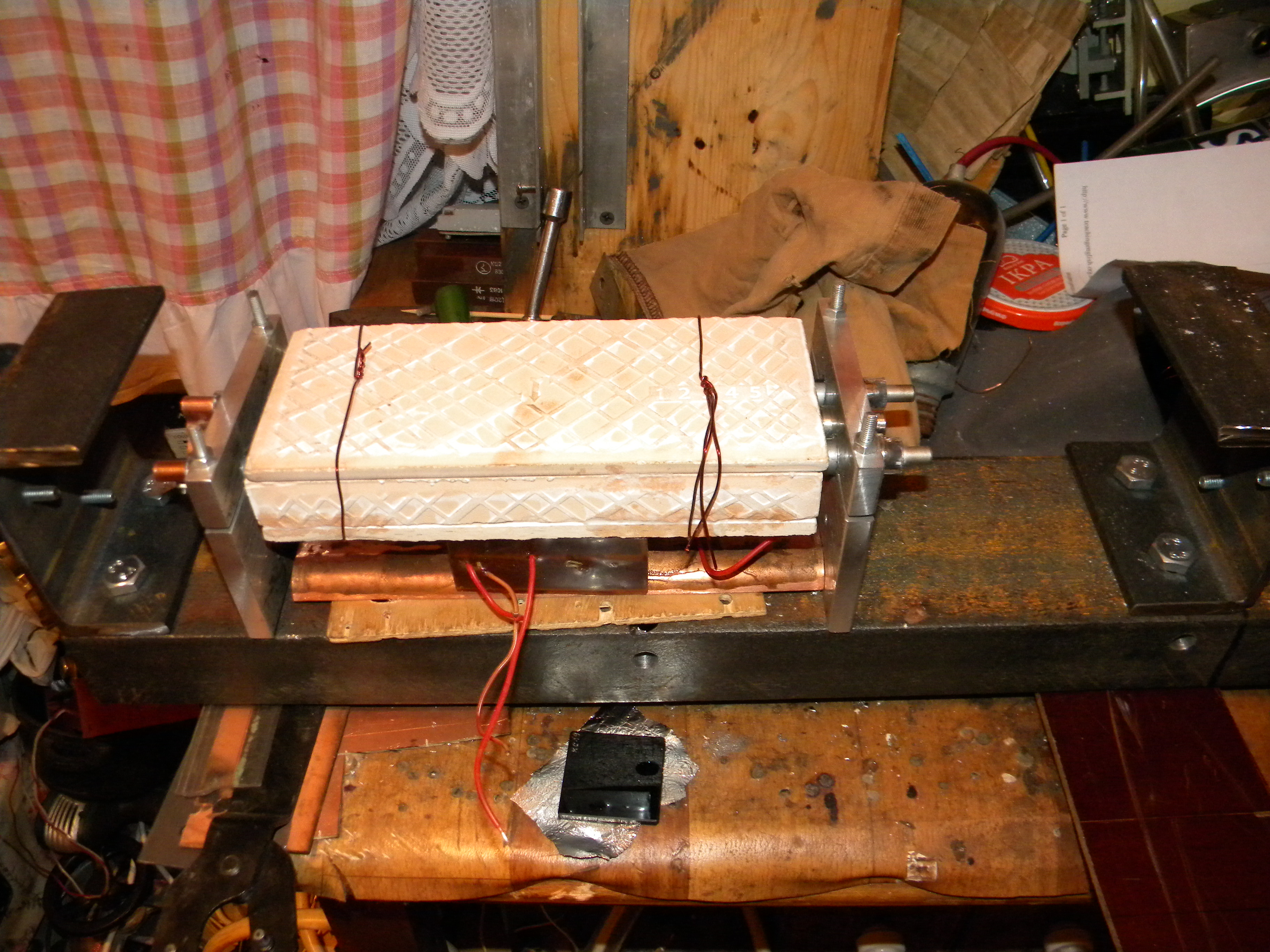
The output mirror was also replaced with a new one with a measured transmittance of 45% at a wavelength of 694 nm.
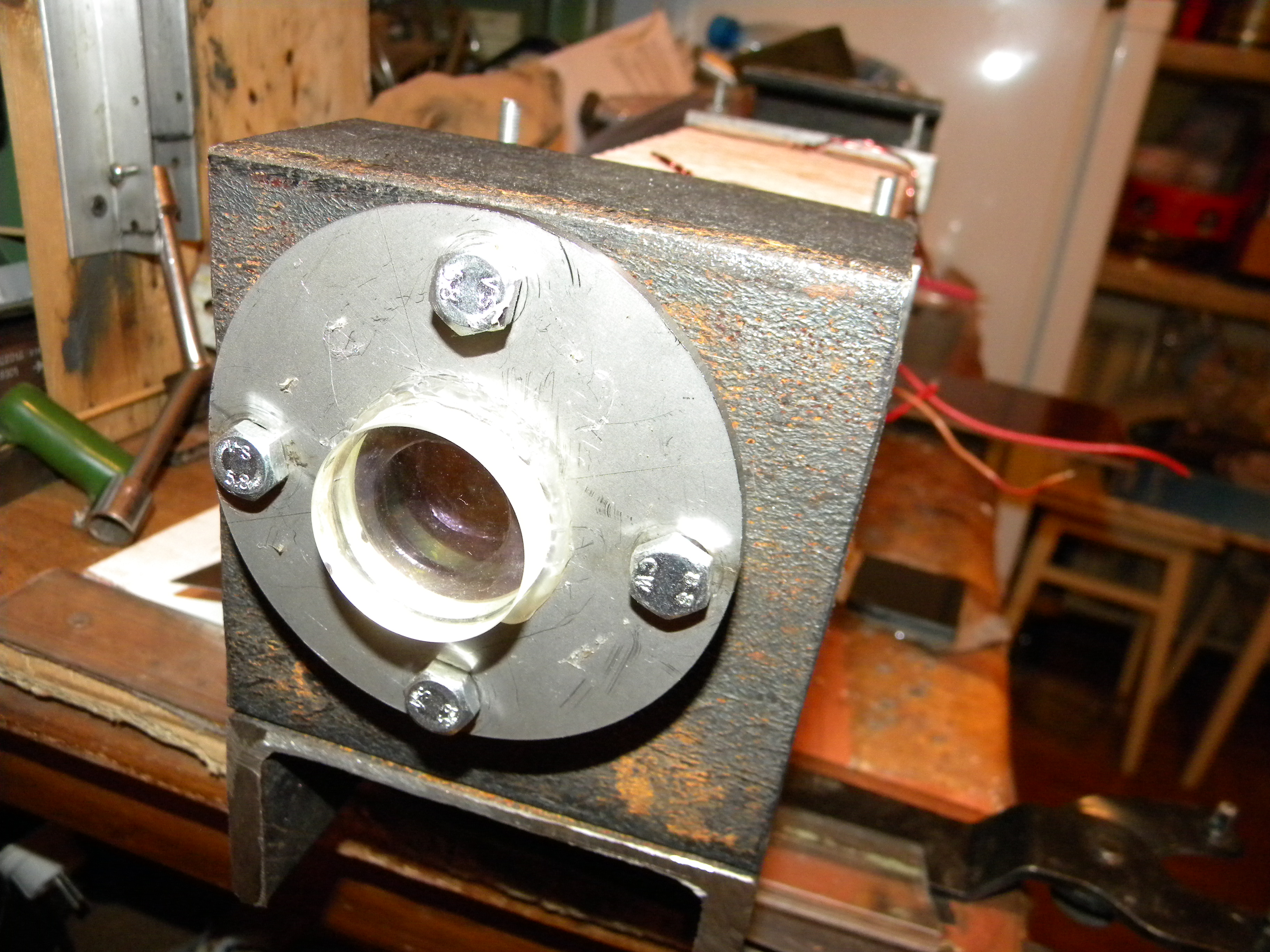
And in this configuration, it was possible to get the generation from the first pulse! The generation threshold turned out to be quite high — about 1500 J of pump energy. The laser gave a beam of rich red color, dazzling brightness. Unfortunately, due to its “transience” it was not possible to photograph it. But it was possible to fix its destructive effect on the metal during focusing. From iron he well sparks.

Since the crystal does not have water cooling, then with an increase in its temperature, the beam energy decreases quite rapidly, up to a complete breakdown of generation. And the tiles were well heated and hampered heat dissipation. When disassembling, I noticed that the surface of the tiles still began to darken. It was decided to test the metal reflector bent from the chrome plate of the photoglazer.
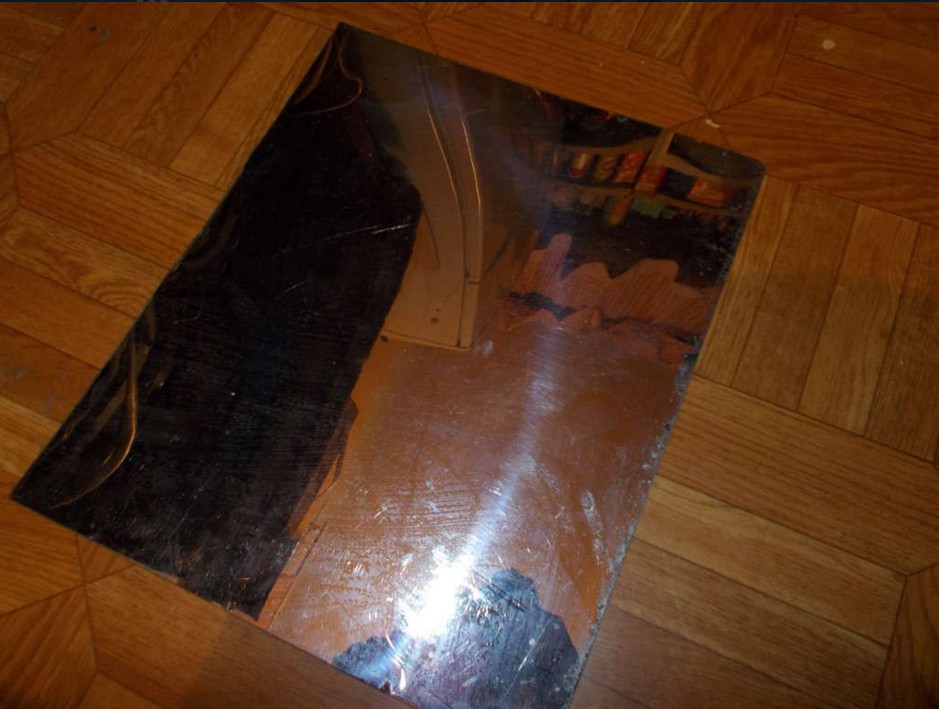
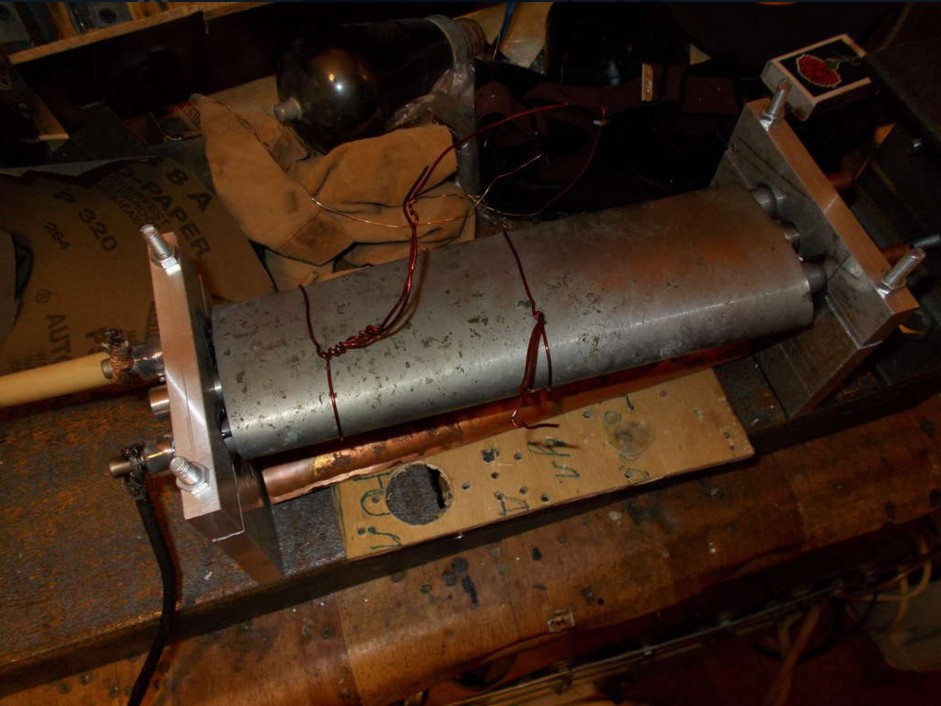
This reflector worked as well as tile, but it cooled down much faster and it was possible to shoot a little more often. There were several firing at metal and rubber. The type of carved sparks depends on the type of metal. Shooting transformer iron. For through breakdown it took 4 shots.
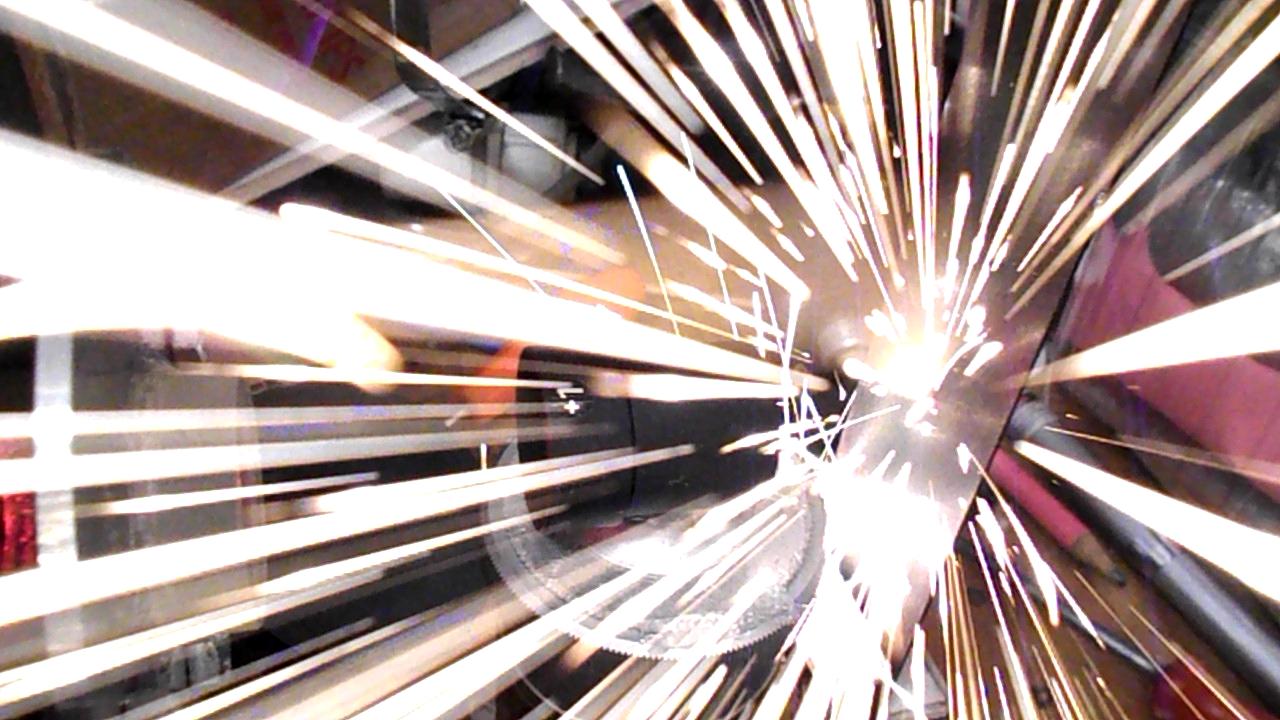
Shooting in stainless steel. Sparks are brighter.

Shooting a carbon steel knife with an office knife gives you plenty of fluffy stars.
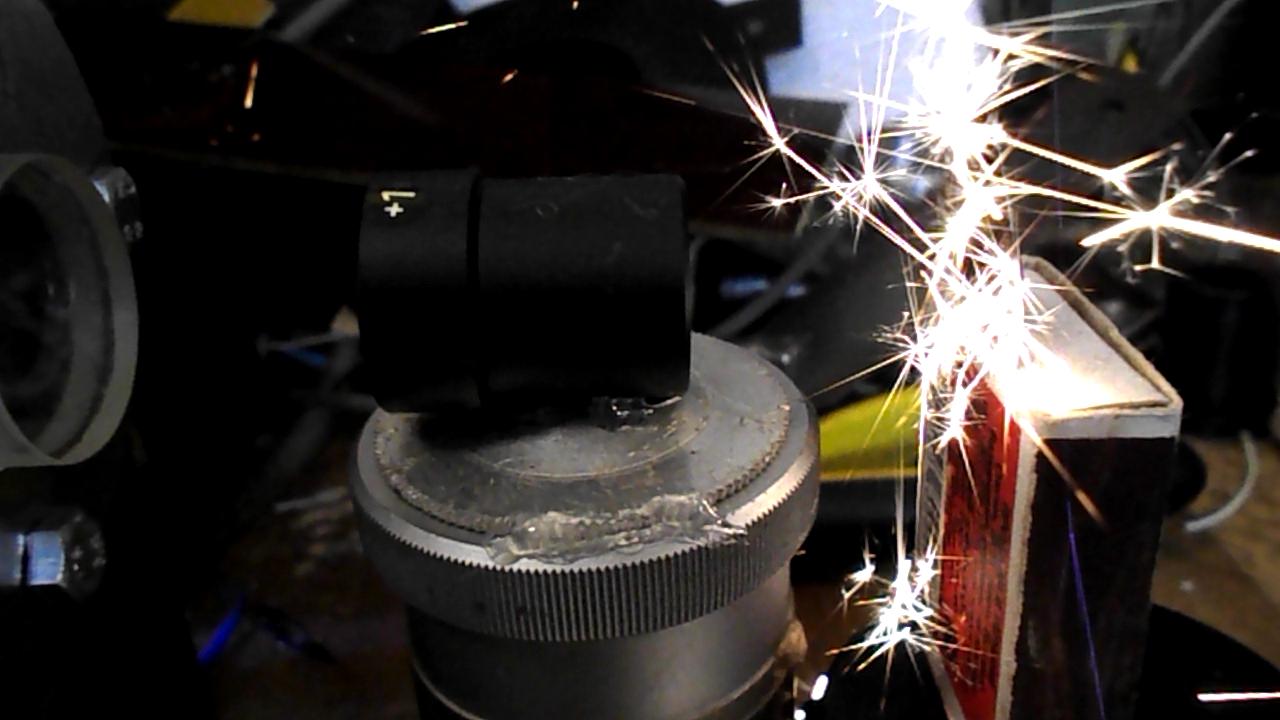
Shooting rubber gives a flame ejection of up to 3-4 cm in length with subsequent smoke rings.
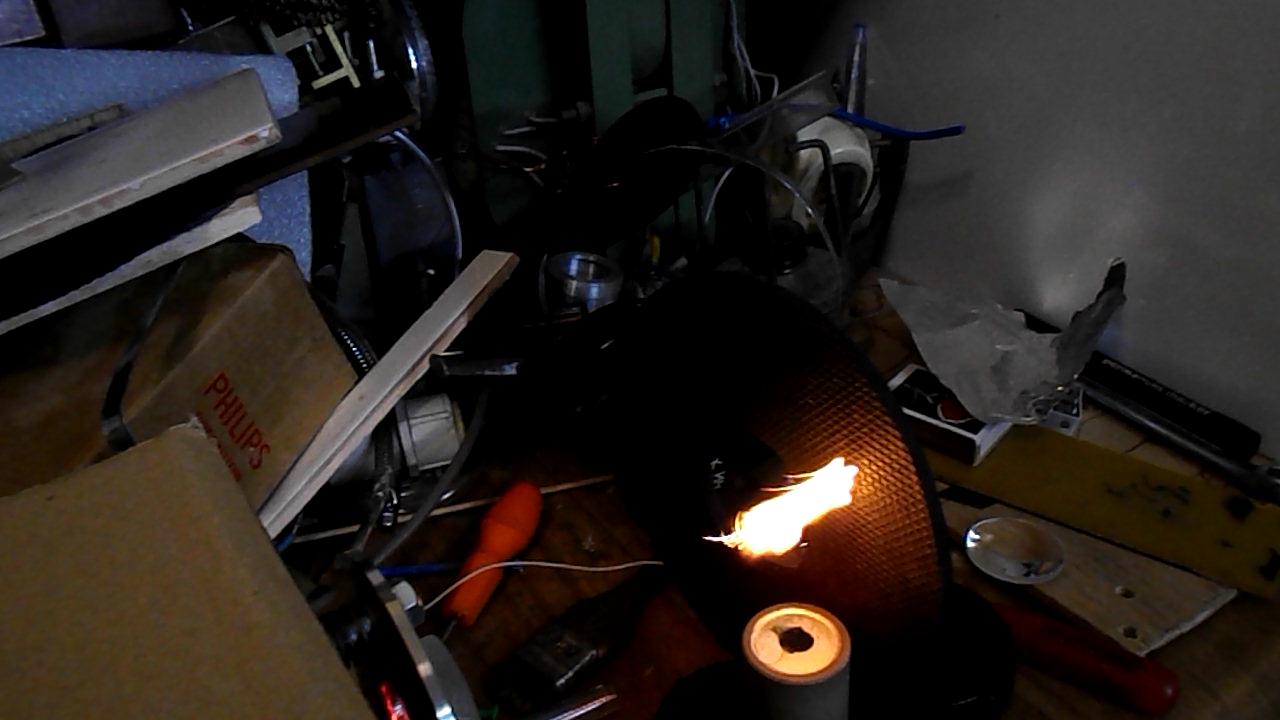
We also managed to find out that due to the use of the prism of total reflection as a deaf mirror, the laser operates in a single-mode mode and delivers energy less than it could, with the same pump level. The fact is that the central edge of a prism is a dead zone and, based on the pattern of the rays of light in the prism of total reflection, the light beam splits into two parallel, which corresponds to the TEM10 mode. This was identified by the spot of burn on black carbolite - it was clearly visible split in half the spot as in the picture.
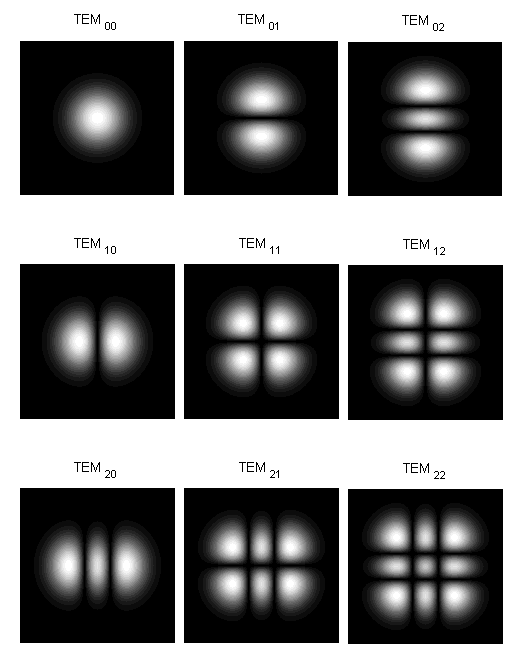
If to create conditions under which all other modes will not be suppressed, then due to the appearance of higher modes, it is possible to achieve an increase in the output energy at least twice. For this, it was necessary to replace the prism, which is easily accessible, with a special deaf mirror, designed for operation at a wavelength of 694 nm. And it was worth it! The generation threshold fell to 900 J, and the energy really became more! And when shooting black carbolite, a uniform burn stain was obtained. Now the plate of transformer iron made its way in 2-3 shots, and the diameter of the hole turned out to be somewhat large. Well, the number of sparks has become significantly more! Especially beautiful is obtained when shooting in carbon steel.
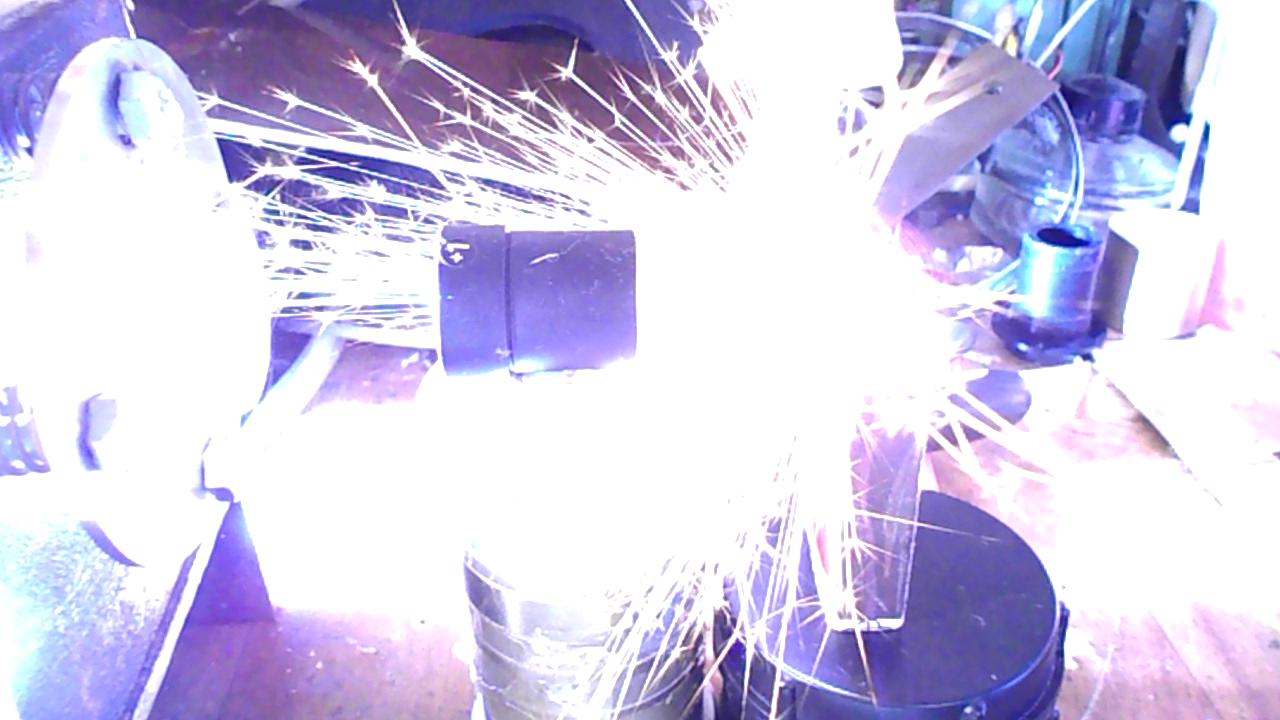
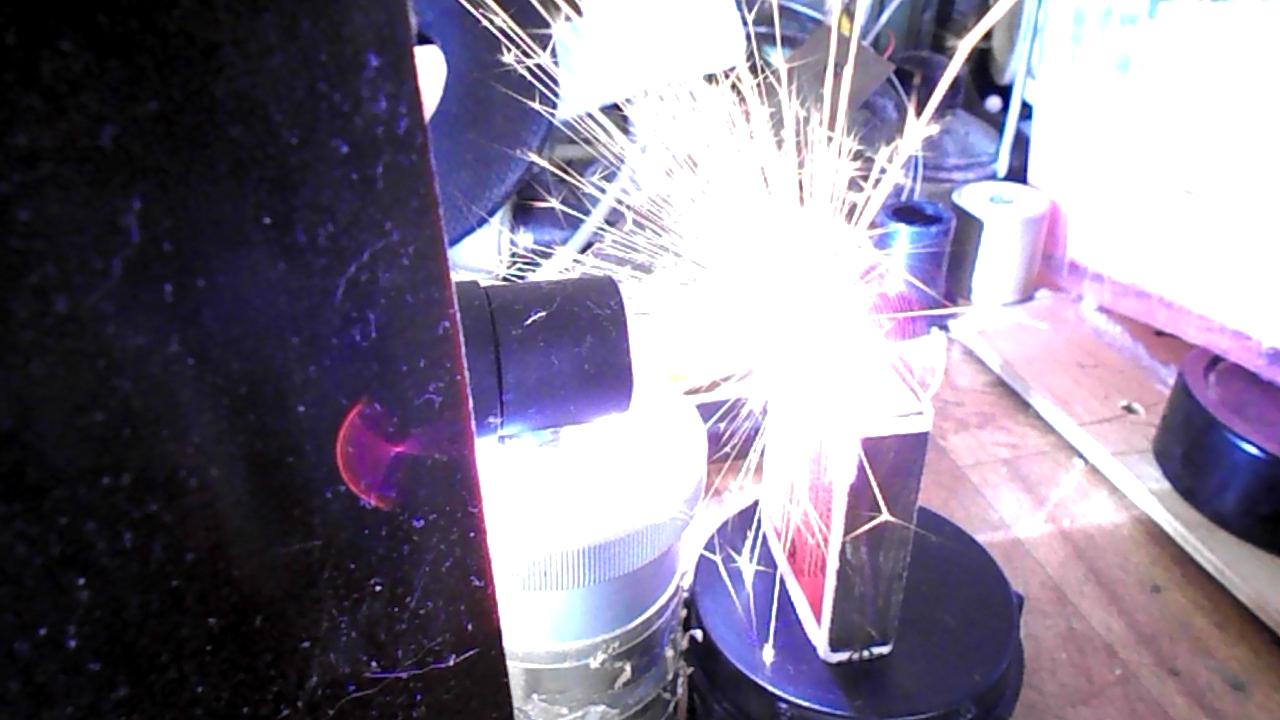

Ordinary steel also sparkles very weakly!
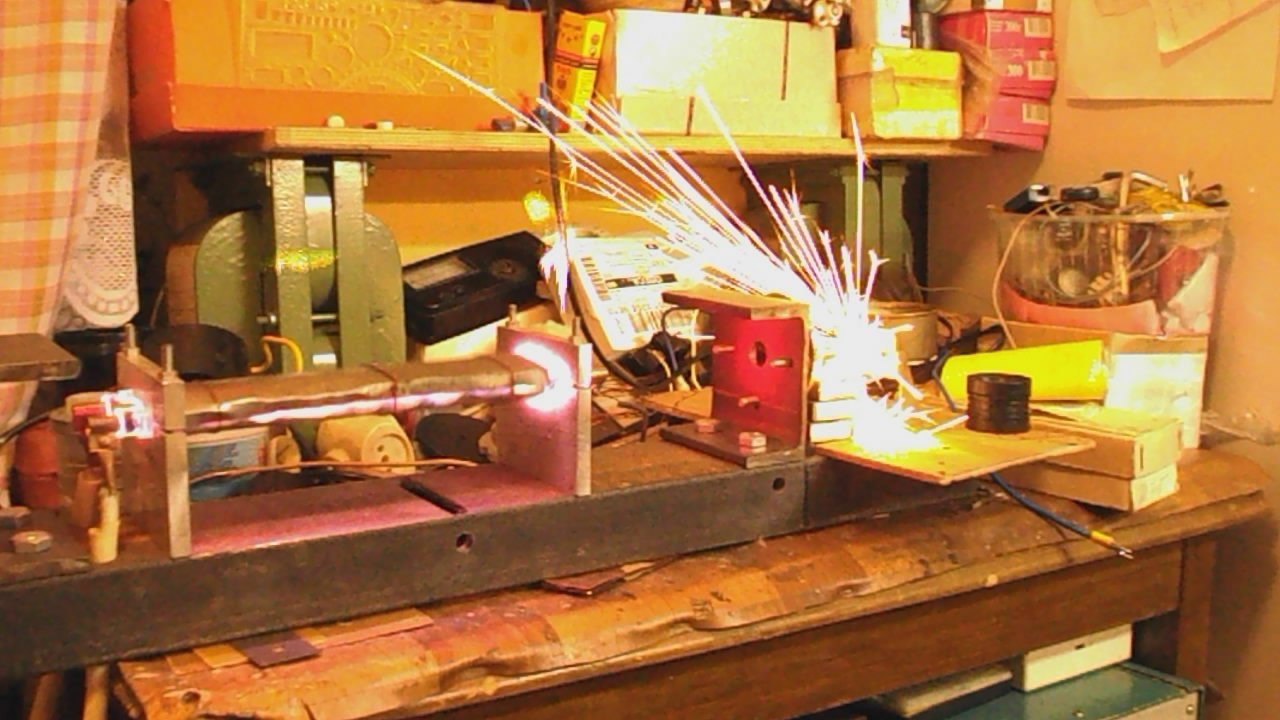
3 shots make a through hole in the blade of the knife.
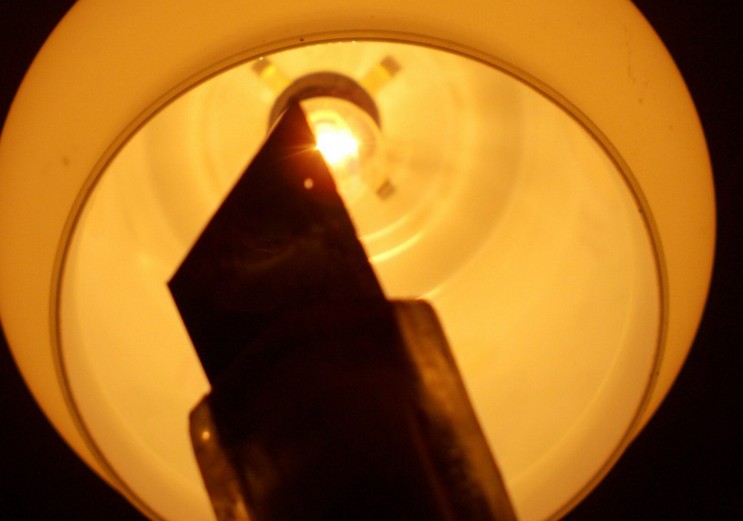
At this point, the laser capabilities were already in principle understandable, and it remained to remove all that mess from the capacitors and the exposed high-voltage wiring to a more or less neat casing, successfully left over from the disassembled LG-70 laser power supply. It was decided to reduce the capacitor battery, leaving only 6 of the same type capacitors, which are perfectly fit into the case. Shooting the rest of the junk did not cause any problems, even there was room for a very important safety node - a vacuum circuit breaker with a normally closed position that discharges capacitors to a powerful resistor when classes with a laser stop and the power supply is de-energized. The charge reliably merges in about 40 seconds. The price for this was a slight decrease in the radiation energy, but then the pump lamps work in a more sparing mode.

At the top are capacitors, to the right is a discharge resistor, in the lower left corner is a lamp ignition system, a round coil to the right is a ballast choke that is turned on to limit the impulse current through the lamps (without it, the lamps solemnly explode after a couple dozen outbursts) a transformer from a Chinese microwave for charging capacitors, even to the right is its starter, and in the lower right corner is a vacuum switch BB-5, which closes the capacitors to a resistor when the device is turned off from the network.
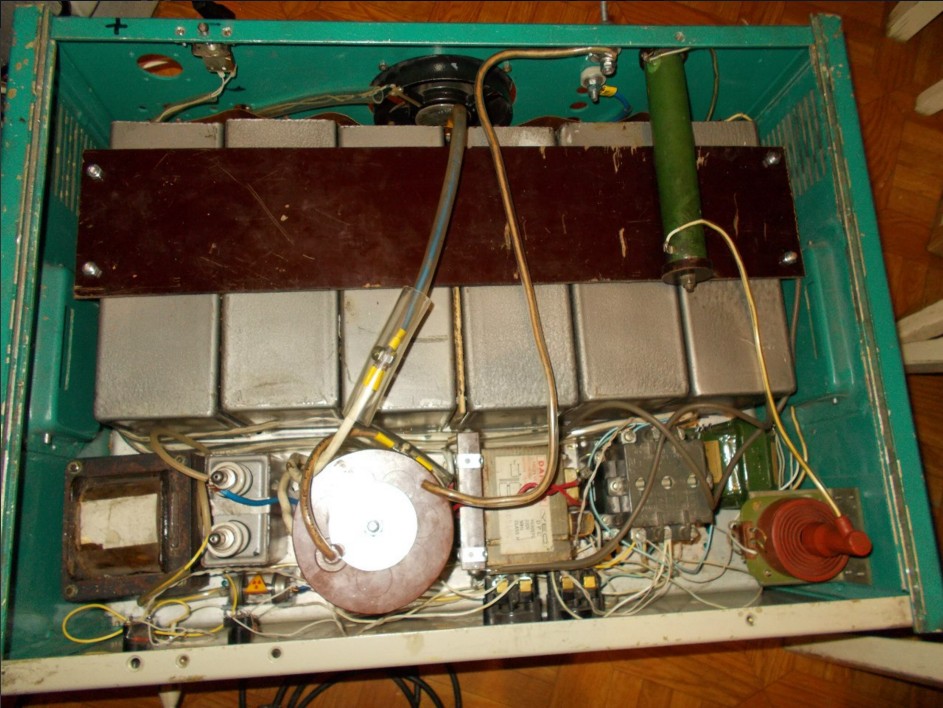
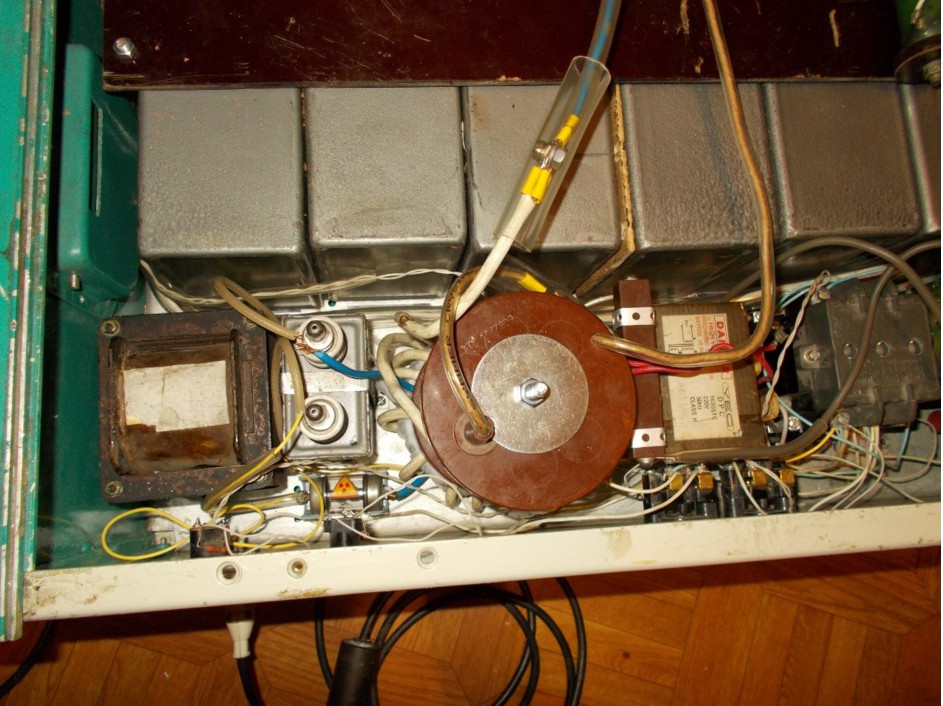
BP view from behind. The fan is standing there simply because he was there, and there was a place for him. Really heated nodes in this block are missing. High voltage is output through two contacts on self-made bushing insulators, which still need to provide additional protection against accidental touches.
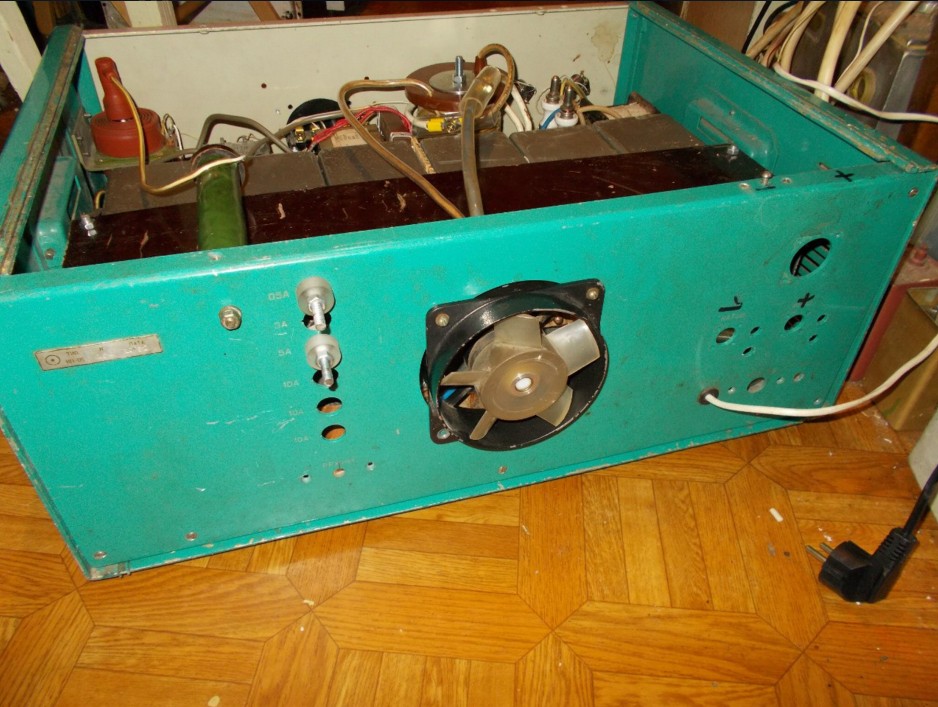
After the power unit was assembled, it was decided to take a penny by storm, made of stainless steel with a thickness of about 1.3 mm. It took about 7 shots, but through the breakdown was received!
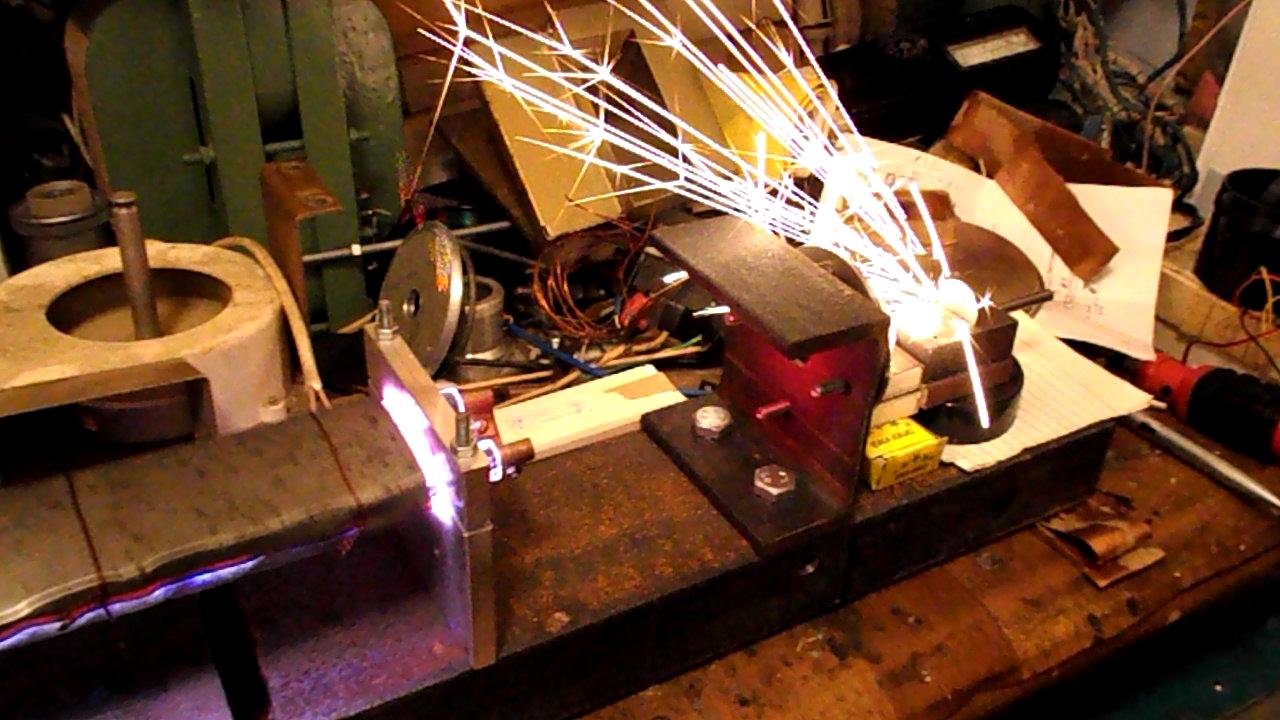

Here you can see sparks from the back side of the coin.
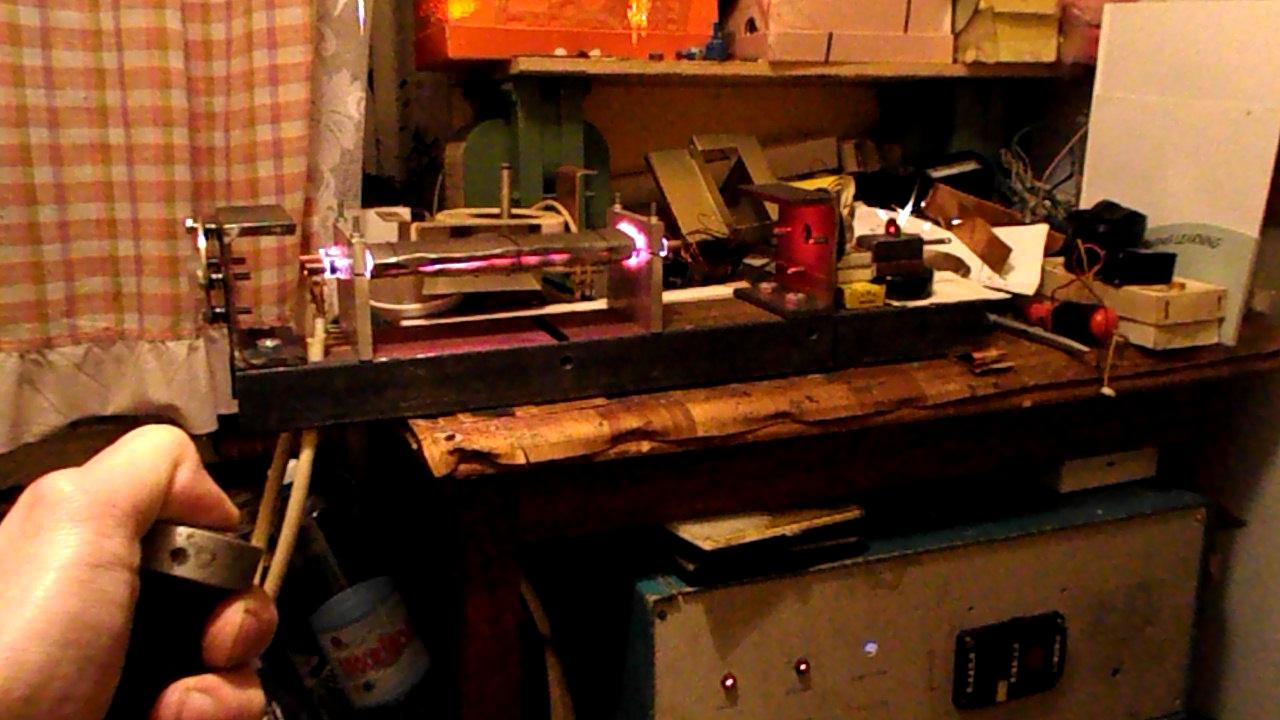
And here is the desired result - through breakdown of the penny.


Summing up, it would be strange if, with my enthusiasm, I would not build this truly outstanding type of laser, which in my realization has an output energy estimated at 5 J when using a full-bodied capacitor bank. It was from him that the history of all laser technology and a completely new at that time science — nonlinear optics — began, which opened up completely unusual incidents occurring with light in the field of high powers and energies. Separately, I would like to thank Jarrod Kinsey, an American laser amateur, with him I was able to discuss the design of my self-made laser, and receive a number of valuable comments from him. The article used materials from the following sources, in addition to the bottomless depths of the Internet:
1. BF Fedorov Optical Quantum Generators, Energia, 1966,
2. B. F. Fedorov Lasers and their applications, “Energy”, 1973
3. A. S. Boreisho Lasers: device and action, St. Petersburg, 1992
Thank you for reading, I hope it was interesting.
And for future projects I have in store a really huge ruby rod - with a diameter of 16mm and with a length of colored part of 240 mm. Full length - 300 mm. From such a crystal one can get up to 100 J of output energy. Almost what you need for a laser blaster.


And Theodor Meiman succeeded in conquering him in the 1960s. He carried out many calculations and came to the conclusion that a ruby crystal would be an ideal working body for generating waves in the optical range. He also proposed the principle of pumping a working medium — short flashes of light from a corresponding flash lamp and a method of creating positive feedback for the amplifier to become a generator — this function was performed by the mirror coatings on the crystal ends. Meiman’s calculations showed that chromium atoms, which are an impurity in sapphire crystals and which make it a ruby, have a suitable system of energy levels that makes it possible to generate laser radiation. The ruby implements the simplest three-level scheme. The chromium atom, absorbing light in the blue-green region of the spectrum, goes to the upper excited level, from which there is a non-radiative transition to a metastable level at which it can linger for a time on the order of 1 ms. From this state, the atom returns to the ground level, emitting a photon with a wavelength of either 694 or 692 nm, since the metastable level is actually not one, there are two very closely spaced ones. The possibility of accumulation of atoms at the metastable level and allows you to create an inverse population, and with it the generation of laser radiation, when one or more spontaneously emitted photons cause all other atoms to crumble all other atoms from the metastable state to the ground one, emitting new photons with the same wavelength, phase, polarization and direction of motion. They create a bright red beam, which is characteristic of coherence. on which he can stay for about 1 ms. From this state, the atom returns to the ground level, emitting a photon with a wavelength of either 694 or 692 nm, since the metastable level is actually not one, there are two very closely spaced ones. The possibility of accumulation of atoms at the metastable level and allows you to create an inverse population, and with it the generation of laser radiation, when one or more spontaneously emitted photons cause all other atoms to crumble all other atoms from the metastable state to the ground one, emitting new photons with the same wavelength, phase, polarization and direction of motion. They create a bright red beam, which is characteristic of coherence. on which he can stay for about 1 ms. From this state, the atom returns to the ground level, emitting a photon with a wavelength of either 694 or 692 nm, since the metastable level is actually not one, there are two very closely spaced ones. The possibility of accumulation of atoms at the metastable level and allows you to create an inverse population, and with it the generation of laser radiation, when one or more spontaneously emitted photons cause all other atoms to crumble all other atoms from the metastable state to the ground one, emitting new photons with the same wavelength, phase, polarization and direction of motion. They create a bright red beam, which is characteristic of coherence. since the metastable level is actually not one, there are two very closely spaced ones. The possibility of accumulation of atoms at the metastable level and allows you to create an inverse population, and with it the generation of laser radiation, when one or more spontaneously emitted photons cause all other atoms to crumble all other atoms from the metastable state to the ground one, emitting new photons with the same wavelength, phase, polarization and direction of motion. They create a bright red beam, which is characteristic of coherence. since the metastable level is actually not one, there are two very closely spaced ones. The possibility of accumulation of atoms at the metastable level and allows you to create an inverse population, and with it the generation of laser radiation, when one or more spontaneously emitted photons cause all other atoms to crumble all other atoms from the metastable state to the ground one, emitting new photons with the same wavelength, phase, polarization and direction of motion. They create a bright red beam, which is characteristic of coherence. when one or several spontaneously emitted photons cause all other atoms to “drop” from the metastable state to the ground state, emitting new photons with the same wavelength, phase, polarization and direction of motion. They create a bright red beam, which is characteristic of coherence. when one or several spontaneously emitted photons cause all other atoms to “drop” from the metastable state to the ground state, emitting new photons with the same wavelength, phase, polarization and direction of motion. They create a bright red beam, which is characteristic of coherence.

Many quite interesting and sometimes very unfair events are connected with the history of the invention of the first optical quantum generator. First, it should be noted that the development of the first laser Meiman carried out on his own initiative and independently, only with his assistant, while the ruby laser was created contrary to the opinions of many experts who were convinced that the ruby is not suitable as a working environment. There is a city legend, according to which, his assistant, being a color blind, for the first time in his life saw a red light, at that moment when the laser was assembled and he started working. According to the same legend, Meiman did not observe the laser beam visually, as he was very busy with the settings of the recording equipment - it was necessary to urgently collect experimental data and prepare the article for publication, in which convincing evidence will be presented that coherent radiation of the optical range was first obtained. This is where the difficulties began. First, Meyman’s article that the generation of coherent optical radiation in a ruby crystal is possible was rejected from the publication in the journal Physical Review Letters, adding that “there’s nothing fundamentally new in his article”. Instead, the article was published in Nature. What is characteristic is that in 1958, an article about the principles of laser operation, directed from a rival organization Bell Labs, was already published in Physical Review Letters, and this despite the fact that they did not have a working laser copy, the article described just a theoretical justification. They quickly cooked up a patent for a laser, which they did not yet have. And Meiman got a deviation from this magazine, although built the first workable laser. Moreover, he later explained in detail to the scientists from Bell Labs in a telephone conversation what it takes to create a laser and how to build it, after he created his own. However, the priority of Meyman in the invention of the laser was never recognized. Yes, and the Nobel Prize for the invention of the laser was awarded to Charles Townes, and not to him, who was supposed to belong to him by right. This is partly explained by the fact that Meiman worked in a private firm that carried out orders for the military, and not in the university laboratory. Yes, and the Nobel Prize for the invention of the laser was awarded to Charles Townes, and not to him, who was supposed to belong to him by right. This is partly explained by the fact that Meiman worked in a private firm that carried out orders for the military, and not in the university laboratory. Yes, and the Nobel Prize for the invention of the laser was awarded to Charles Townes, and not to him, who was supposed to belong to him by right. This is partly explained by the fact that Meiman worked in a private firm that carried out orders for the military, and not in the university laboratory.
Now, let's leave the drama alone and see how Meiman's ruby laser was made in the gland. The design was extremely simple - in a compact case was a miniature spiral flash lamp, inside which was fixed even more miniature ruby crystal. The opposite ends of it were silver-plated - one end was a “deaf” mirror, the second was silver-plated with a thinner layer that let in a certain amount of light. The first laser in the world was 12 centimeters long, weighed 300 grams and looked like a toy.

Details of the laser close-up:

Actually, a ruby crystal.

And the entire laser assembly, without a power source.

The photo also got a photo of a laser of a larger size, but by no means the first in history. And the journalists immediately began to raise panic, they say, the "death rays" were invented.

Literally a year or two later, when the news of the invention of the laser had already spread around the world, the first laboratory samples of lasers in the USSR began to appear. Unlike Western countries, spiral pump lamps in lasers did not catch on immediately. Firstly, the spiral lamp in spite of its “obviousness” has far from the optimal shape of the glow body - only a small fraction of the light goes to the address, since the neighboring turns of the spiral mainly illuminate each other, rather than a ruby crystal inserted inside it. Secondly - the Soviet industry did not produce a wide range of spiral flash lamps. And those that were produced had the wrong shape - the helix was too large in diameter but few turns, such as the fairly well-known lamps IFK-20000 and IFK-80000. There was a spiral modification in the fairly well-known and widespread IFK-2000 lamp, but it is very rare and could only “pump” the smallest crystal of ruby, like Meiman’s. Since spiral lamps in the USSR were rare, they took the path of using those lamps that are in sufficient quantity. The first laser in the USSR had the opportunity to install crystals of various sizes into it, and the “classic” U-shaped lamps IFK-2000 were used for pumping. So he looked "alive."

And so it was shown in the books of B. F. Fedorov of various publications.


Since this method of pumping still remains inefficient, it quickly went away in favor of pumping with direct tubular lamps of the IFP series. Ruby crystals also began to be produced only a few standard sizes, exactly the size of the luminous part of the lamp. The ruby crystal and the lamp were placed in the foci of an elliptical reflector so that the crystal would collect the maximum available light. So it looks like a schematic.

And it looks like an elliptical reflector live.

There was also a design with the so-called "cavity" lamp. A cavity lamp is obtained by gradually increasing the number of turns in the spiral lamp to infinity, until they merge into a solid cavity. Such a lamp consists of two quartz glass tubes nested inside one another and soldered at the ends. Electrodes are soldered to opposite ends of the lamp. The only well-known Soviet-made cavity lamp, IPPP-7000, was used in pumping the UIG-1 laser setup.

Such a pumping circuit has all the drawbacks of a spiral lamp circuit, and therefore has not been applied anywhere else. The photo shows the IPPP-7000 lamp and a ruby crystal used with it. In addition to the now exotic circuits with spiral and cavity pump lamps, the ruby laser can work in an even more exotic scheme - with continuous pumping. This is possible if the ruby crystal is very small, is cooled with liquid nitrogen and is illuminated by a focused beam from a superhigh-pressure mercury lamp or a high-power argon laser beam. But such devices did not leave the walls of the laboratories, remaining exotic, described in scientific articles, despite the fact that over time he was able to "wean" from liquid nitrogen. Subsequently, they refused from the mirrors sprayed on the ends, since they are short-lived and in case of damage they will have to change the whole crystal. This design has been preserved only in those devices where maximum compactness is needed, such as, for example, in laser emitters of epilators. In all other mirrors mounted separately on the adjustment devices.
It would be strange if I didn’t want to build my own ruby laser using an
The information is presented for informational purposes only. The author is not responsible for trying to repeat the above.
The basis was the above-mentioned crystal from the installation of UIG-1. This is a crystal of pale pink color with the size of the working colored part of 8 * 120 mm, with additional colorless tips, which gives a total crystal length of 180 mm. Tips needed for mounting the crystal in the emitter housing. Another reason why the colored part is made exactly according to the size of the pump lamp is that the ruby has an extremely poor ability to absorb its own radiation at the generation wavelength. If any part of the crystal remains unoccupied, then it begins to absorb radiation, which is amplified in the lighted part, and the efficiency of the laser is greatly reduced. Due to this three-level scheme of chromium atoms in ruby. For the same reason, the ruby has a very high threshold pumping energy.
The first was built power supply layout for the pumping lamp. Its main component is a battery of 1000 μF capacitors, which is charged up to 3 kV.
Let me remind you that circuits with high-voltage high-capacity capacitors are deadly!

The charge and ignition scheme of the lamp. For the first attempt taken IPP-5000.

At first the circuit with the lamp was tested without any housing. The flash of the lamp is extremely powerful, it happens with a sufficiently loud pop, and it is easily seen in the next rooms - the light propagates through the corridor, reflecting off the walls. The flash of the lamp is capable of charring wood and paper, placed against it at its support. Each flash is accompanied by the smell of burnt dust and ozone, produced by a powerful impulse of a hard ultraviolet, and is accompanied by a wave of heat, if you are near it. Direct flash observation without eye protection is extremely dangerous! For protection, a conventional welding mask or goggles is sufficient.
Having played enough with the most powerful flashlight at that time, I assembled an emitter with this lamp and the crystal shown above. The case for the lamp and the crystal was a glass monoblock reflector from the Kvant-16 technological laser, and a piece of metal channel became the basement. Alignment devices for resonator mirrors were made from pieces of the same channel.


As a deaf mirror, I decided to use the prism of total reflection.

And as a day off, a mirror was supposedly chosen from a ruby laser.
Looking ahead, I will say that this construct was inoperative. Laser generation was not possible to get on it. The reasons are quite obvious - the pumping lamp is twice as long as the crystal and its light is used extremely inefficiently. And the possibility of the output mirror to provide this generation also raised questions. Quantron (the so-called lamp unit + crystal + reflector) had to be redone. In the second version, I made a new holder for the crystal and the lamps, instead of a single lamp, the IFP5000 decided to use two IFP2000 lamps placed in the focus against the crystal and connected in series electrically. The length of the IPP2000 ideally corresponds to the length of the colored part of the crystal. This layout method is called “tight packaging.”

As a reflector, it was decided to try white tiles. The current trend in commercial laser engineering is the use of ceramic diffuse reflectors made of sintered aluminum oxide, which reflects up to 97% of the incident light. Of course, branded reflectors are not available to me, but the tiles look just as good, also perfectly white.


The output mirror was also replaced with a new one with a measured transmittance of 45% at a wavelength of 694 nm.

And in this configuration, it was possible to get the generation from the first pulse! The generation threshold turned out to be quite high — about 1500 J of pump energy. The laser gave a beam of rich red color, dazzling brightness. Unfortunately, due to its “transience” it was not possible to photograph it. But it was possible to fix its destructive effect on the metal during focusing. From iron he well sparks.

Since the crystal does not have water cooling, then with an increase in its temperature, the beam energy decreases quite rapidly, up to a complete breakdown of generation. And the tiles were well heated and hampered heat dissipation. When disassembling, I noticed that the surface of the tiles still began to darken. It was decided to test the metal reflector bent from the chrome plate of the photoglazer.


This reflector worked as well as tile, but it cooled down much faster and it was possible to shoot a little more often. There were several firing at metal and rubber. The type of carved sparks depends on the type of metal. Shooting transformer iron. For through breakdown it took 4 shots.

Shooting in stainless steel. Sparks are brighter.

Shooting a carbon steel knife with an office knife gives you plenty of fluffy stars.

Shooting rubber gives a flame ejection of up to 3-4 cm in length with subsequent smoke rings.

We also managed to find out that due to the use of the prism of total reflection as a deaf mirror, the laser operates in a single-mode mode and delivers energy less than it could, with the same pump level. The fact is that the central edge of a prism is a dead zone and, based on the pattern of the rays of light in the prism of total reflection, the light beam splits into two parallel, which corresponds to the TEM10 mode. This was identified by the spot of burn on black carbolite - it was clearly visible split in half the spot as in the picture.

If to create conditions under which all other modes will not be suppressed, then due to the appearance of higher modes, it is possible to achieve an increase in the output energy at least twice. For this, it was necessary to replace the prism, which is easily accessible, with a special deaf mirror, designed for operation at a wavelength of 694 nm. And it was worth it! The generation threshold fell to 900 J, and the energy really became more! And when shooting black carbolite, a uniform burn stain was obtained. Now the plate of transformer iron made its way in 2-3 shots, and the diameter of the hole turned out to be somewhat large. Well, the number of sparks has become significantly more! Especially beautiful is obtained when shooting in carbon steel.



Ordinary steel also sparkles very weakly!

3 shots make a through hole in the blade of the knife.

At this point, the laser capabilities were already in principle understandable, and it remained to remove all that mess from the capacitors and the exposed high-voltage wiring to a more or less neat casing, successfully left over from the disassembled LG-70 laser power supply. It was decided to reduce the capacitor battery, leaving only 6 of the same type capacitors, which are perfectly fit into the case. Shooting the rest of the junk did not cause any problems, even there was room for a very important safety node - a vacuum circuit breaker with a normally closed position that discharges capacitors to a powerful resistor when classes with a laser stop and the power supply is de-energized. The charge reliably merges in about 40 seconds. The price for this was a slight decrease in the radiation energy, but then the pump lamps work in a more sparing mode.

At the top are capacitors, to the right is a discharge resistor, in the lower left corner is a lamp ignition system, a round coil to the right is a ballast choke that is turned on to limit the impulse current through the lamps (without it, the lamps solemnly explode after a couple dozen outbursts) a transformer from a Chinese microwave for charging capacitors, even to the right is its starter, and in the lower right corner is a vacuum switch BB-5, which closes the capacitors to a resistor when the device is turned off from the network.


BP view from behind. The fan is standing there simply because he was there, and there was a place for him. Really heated nodes in this block are missing. High voltage is output through two contacts on self-made bushing insulators, which still need to provide additional protection against accidental touches.

After the power unit was assembled, it was decided to take a penny by storm, made of stainless steel with a thickness of about 1.3 mm. It took about 7 shots, but through the breakdown was received!


Here you can see sparks from the back side of the coin.

And here is the desired result - through breakdown of the penny.


Summing up, it would be strange if, with my enthusiasm, I would not build this truly outstanding type of laser, which in my realization has an output energy estimated at 5 J when using a full-bodied capacitor bank. It was from him that the history of all laser technology and a completely new at that time science — nonlinear optics — began, which opened up completely unusual incidents occurring with light in the field of high powers and energies. Separately, I would like to thank Jarrod Kinsey, an American laser amateur, with him I was able to discuss the design of my self-made laser, and receive a number of valuable comments from him. The article used materials from the following sources, in addition to the bottomless depths of the Internet:
1. BF Fedorov Optical Quantum Generators, Energia, 1966,
2. B. F. Fedorov Lasers and their applications, “Energy”, 1973
3. A. S. Boreisho Lasers: device and action, St. Petersburg, 1992
Thank you for reading, I hope it was interesting.
And for future projects I have in store a really huge ruby rod - with a diameter of 16mm and with a length of colored part of 240 mm. Full length - 300 mm. From such a crystal one can get up to 100 J of output energy. Almost what you need for a laser blaster.

